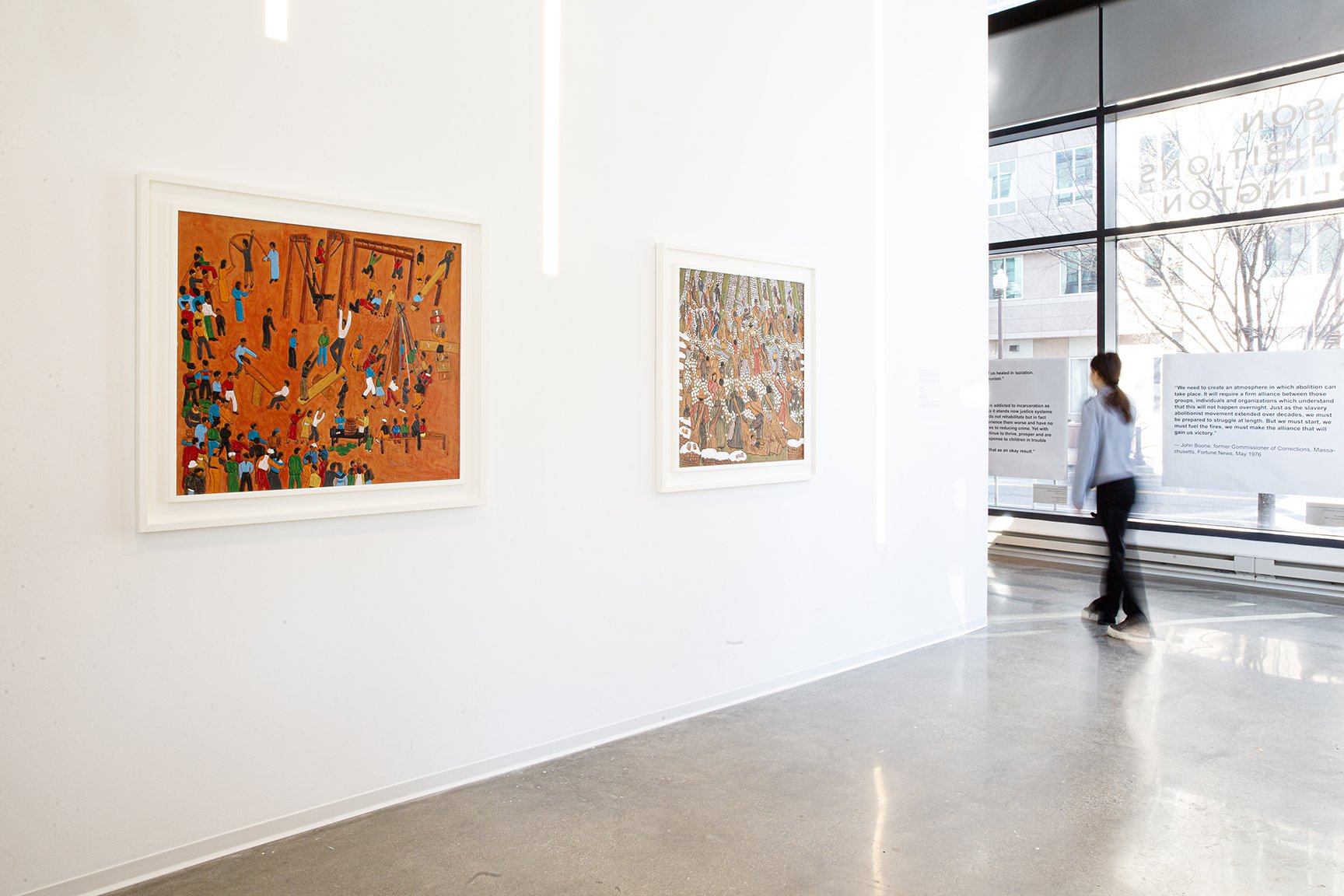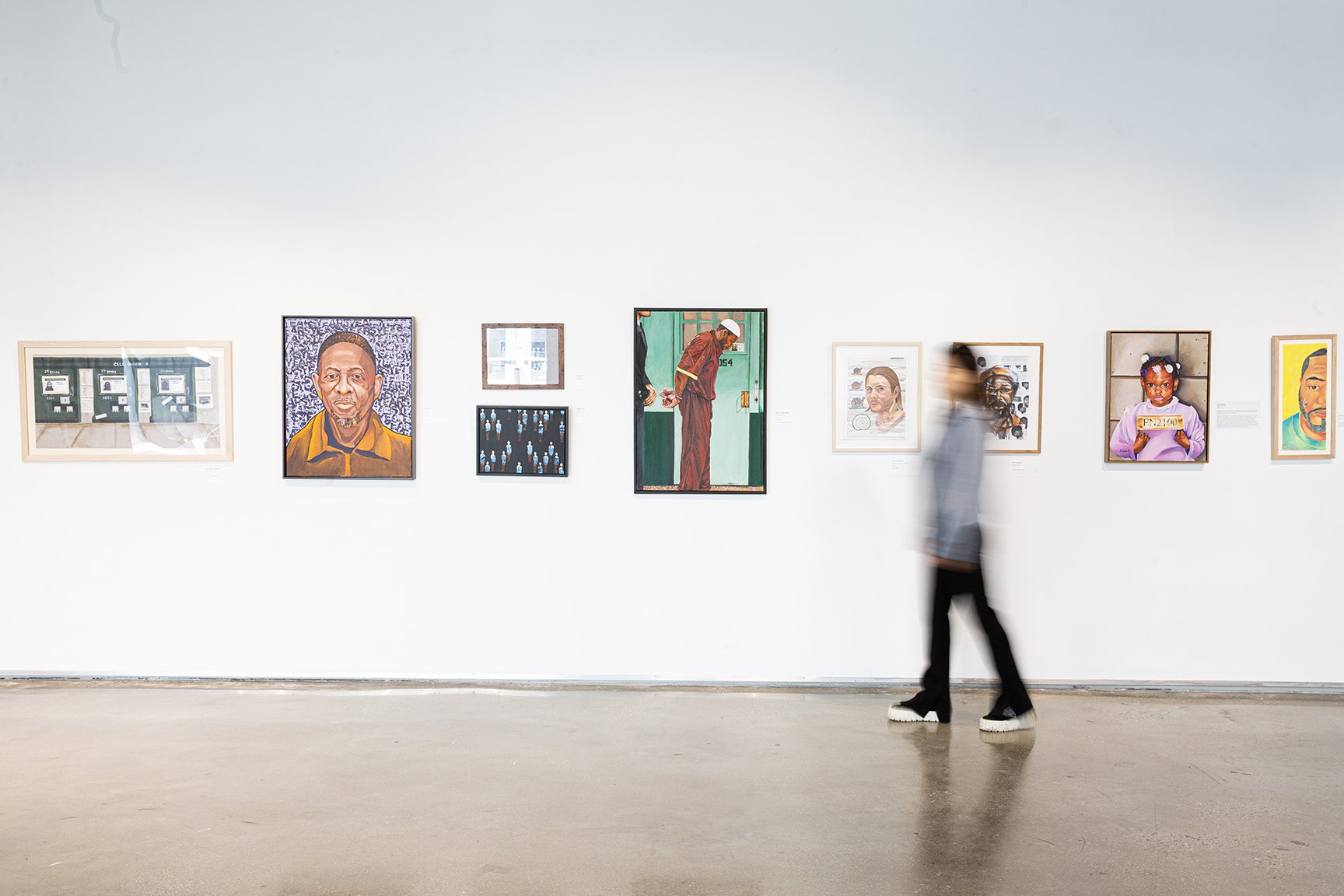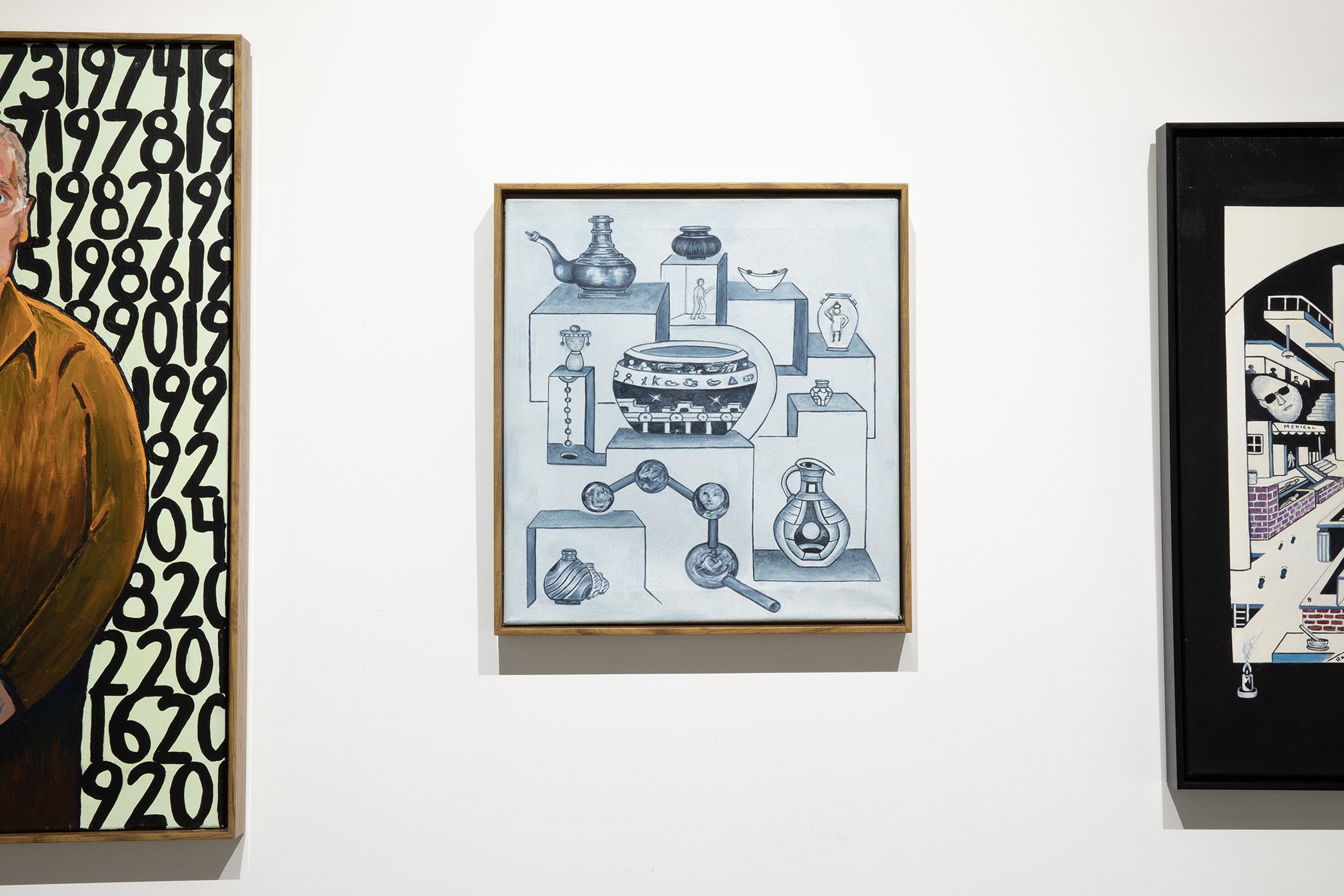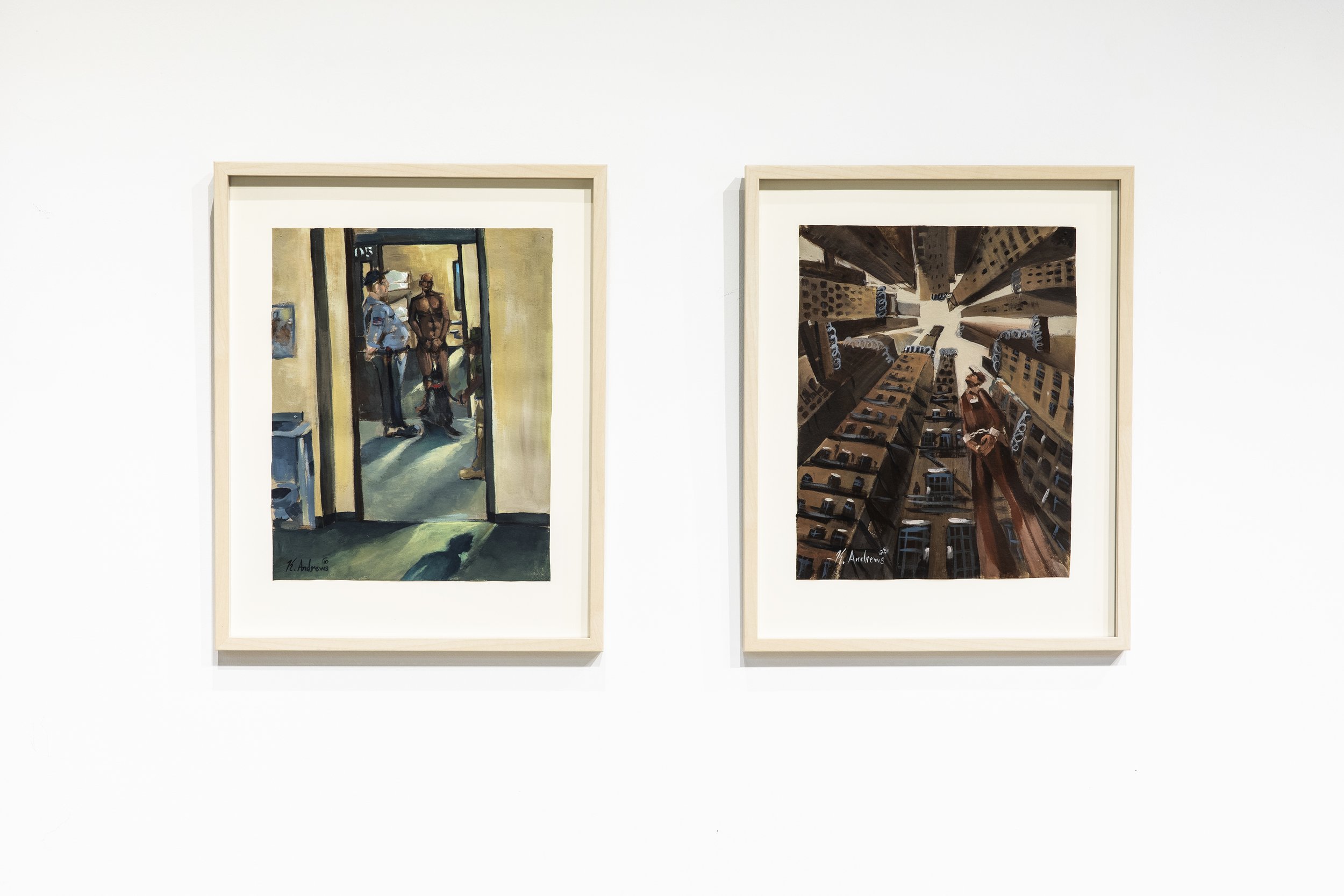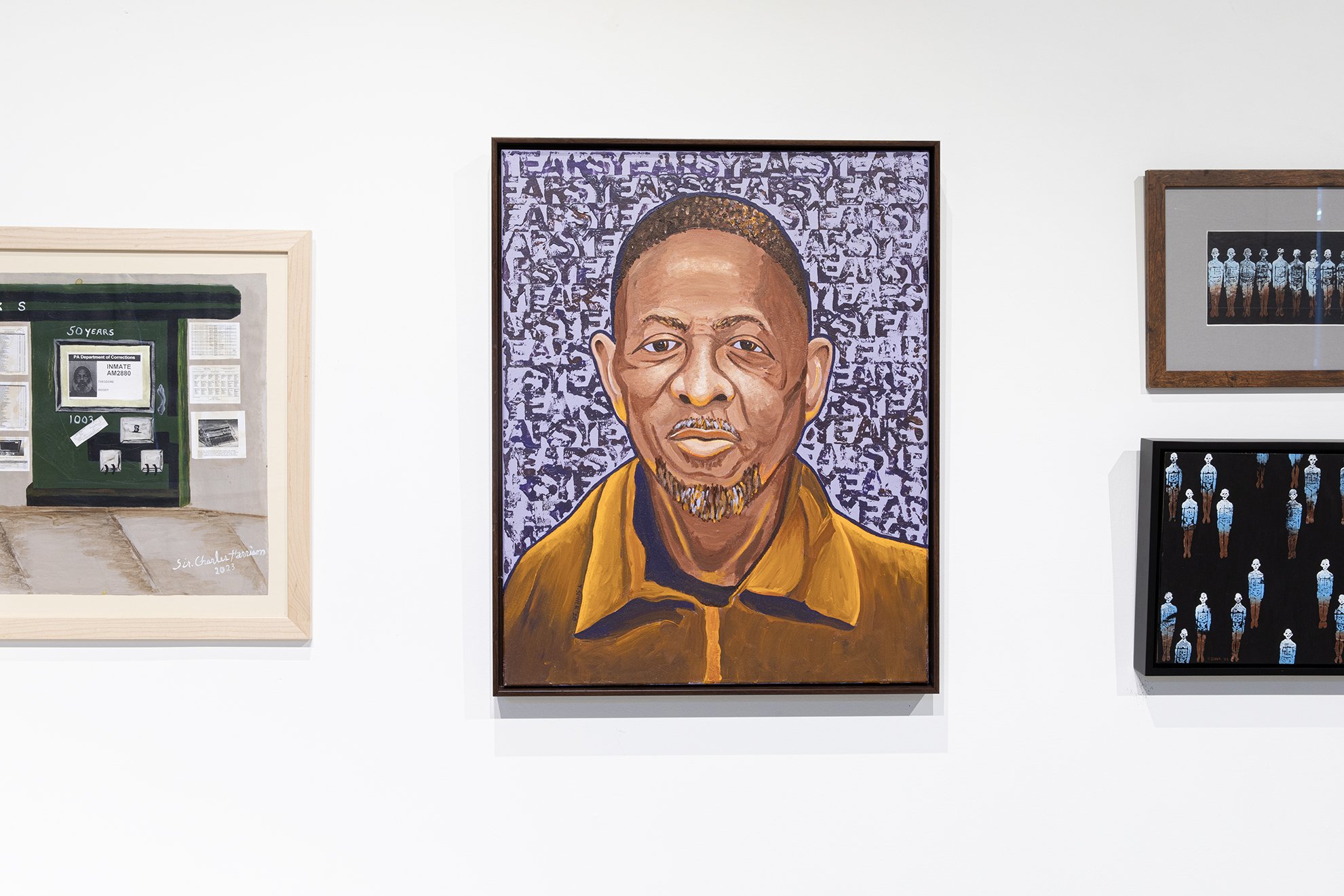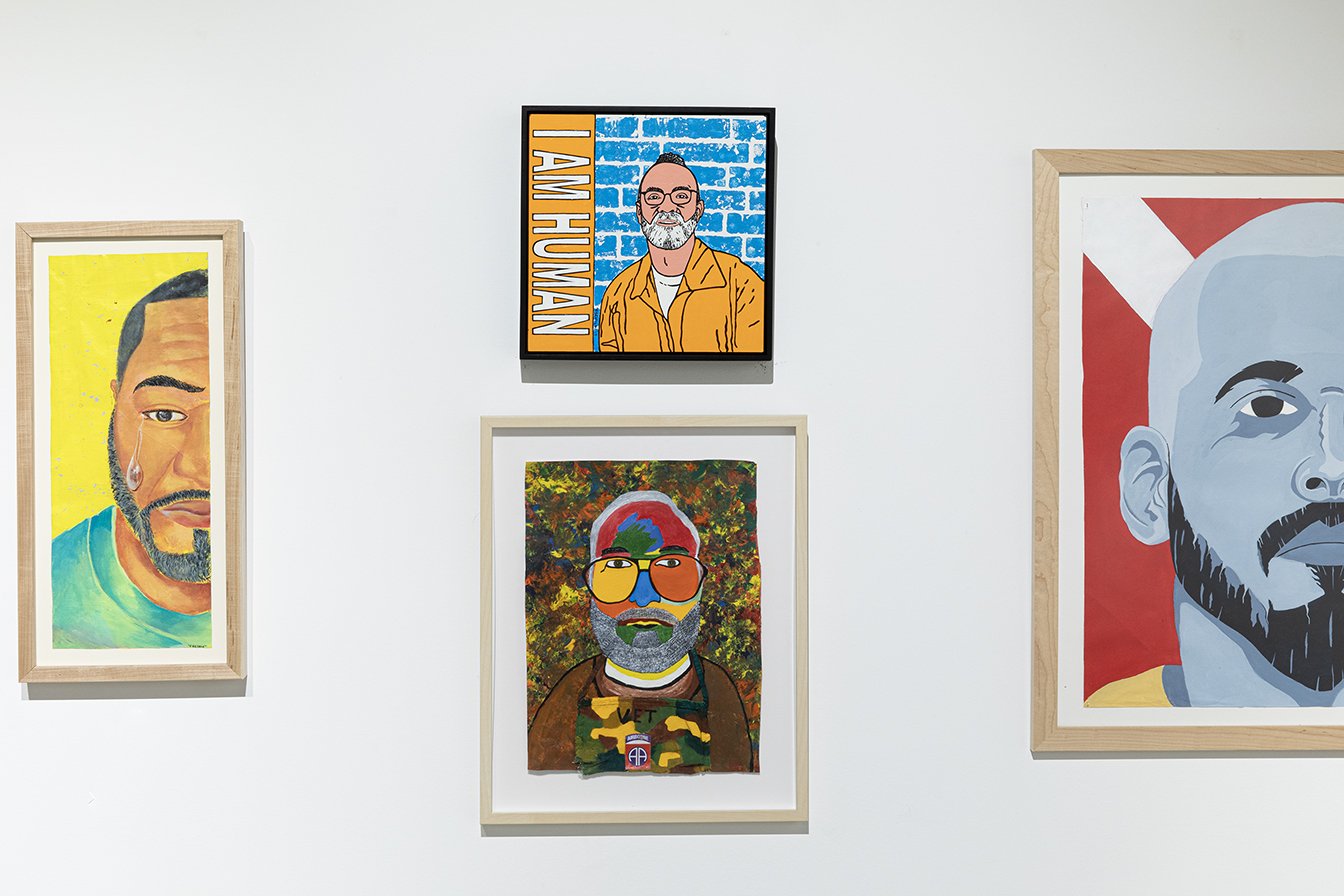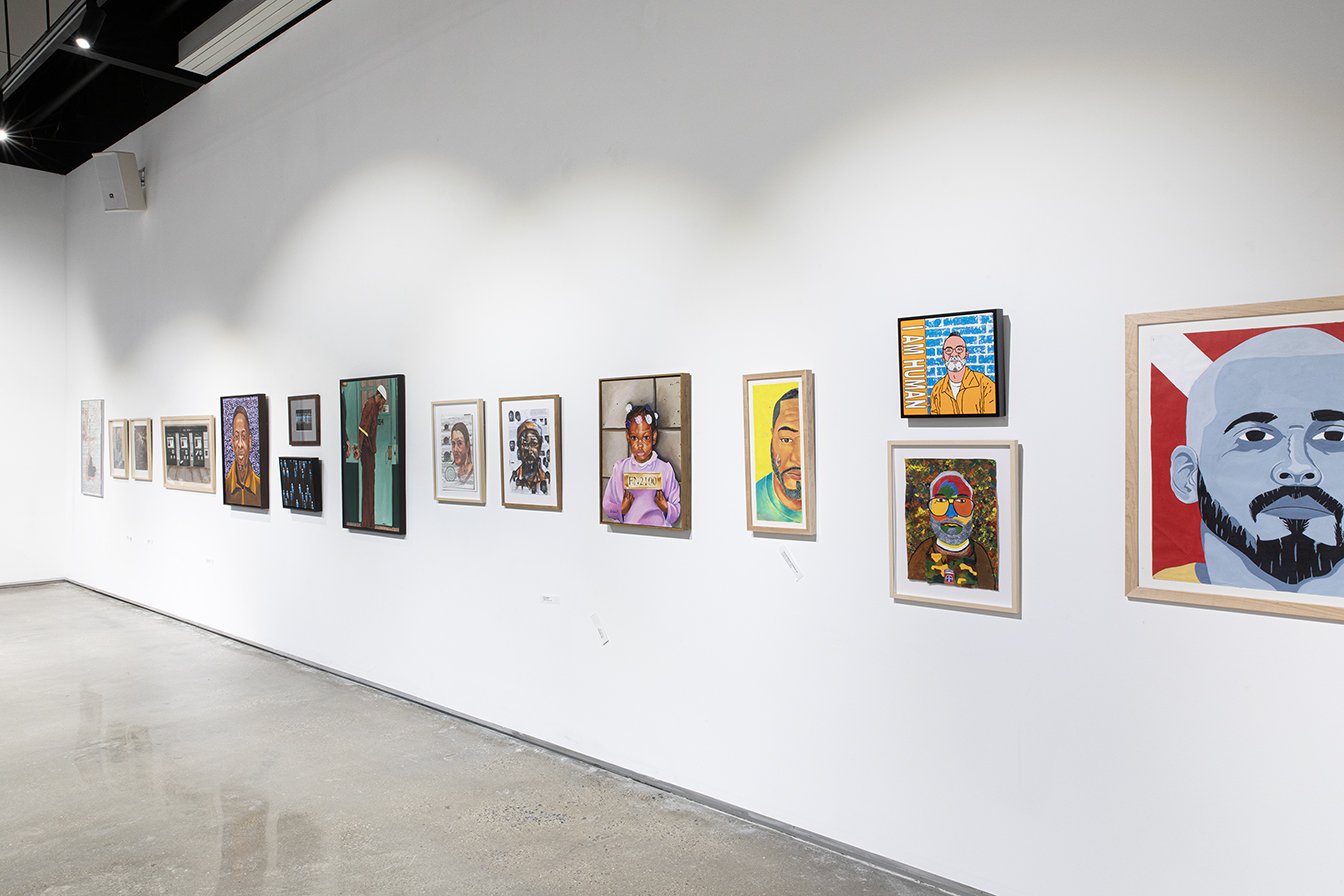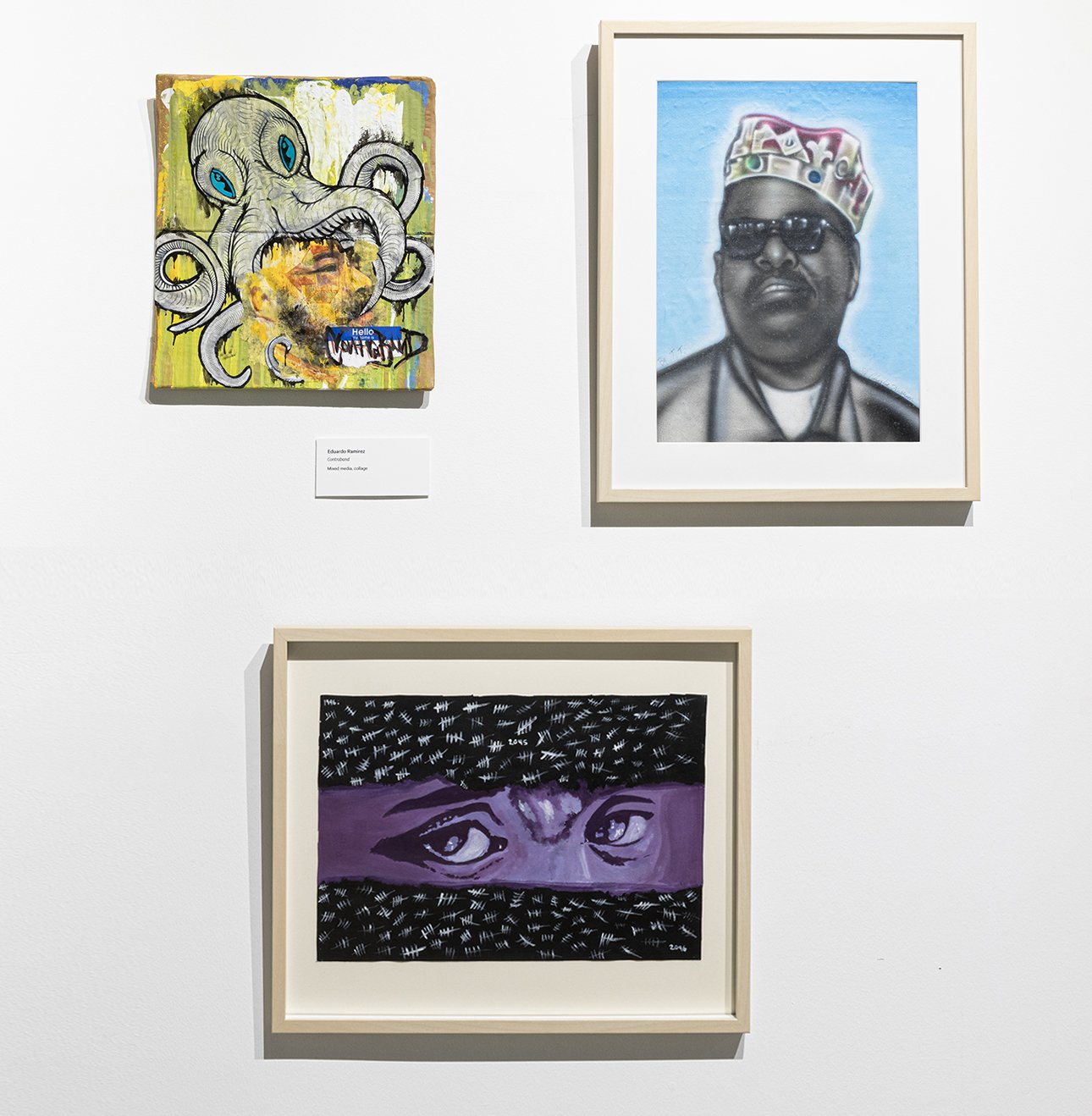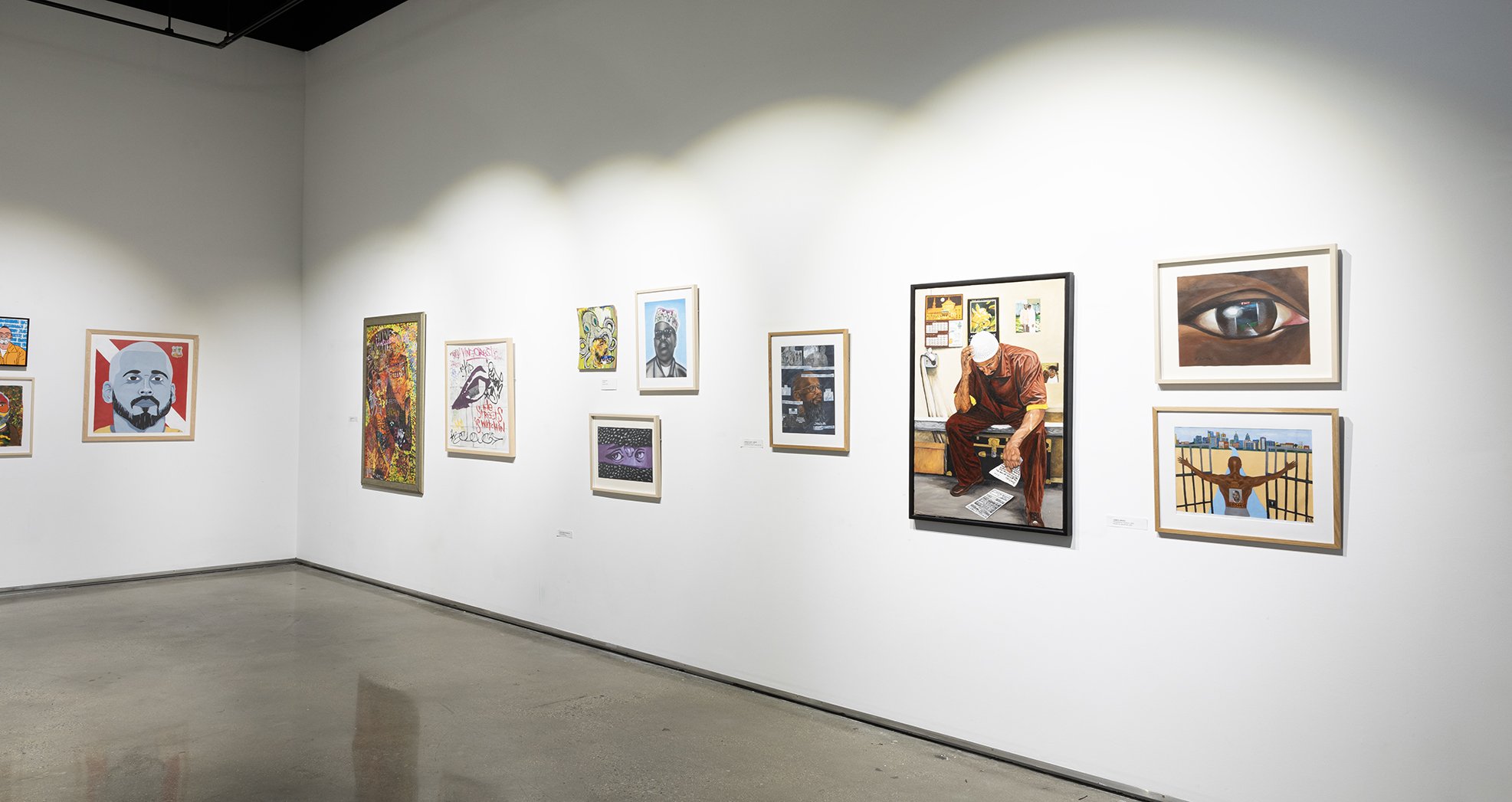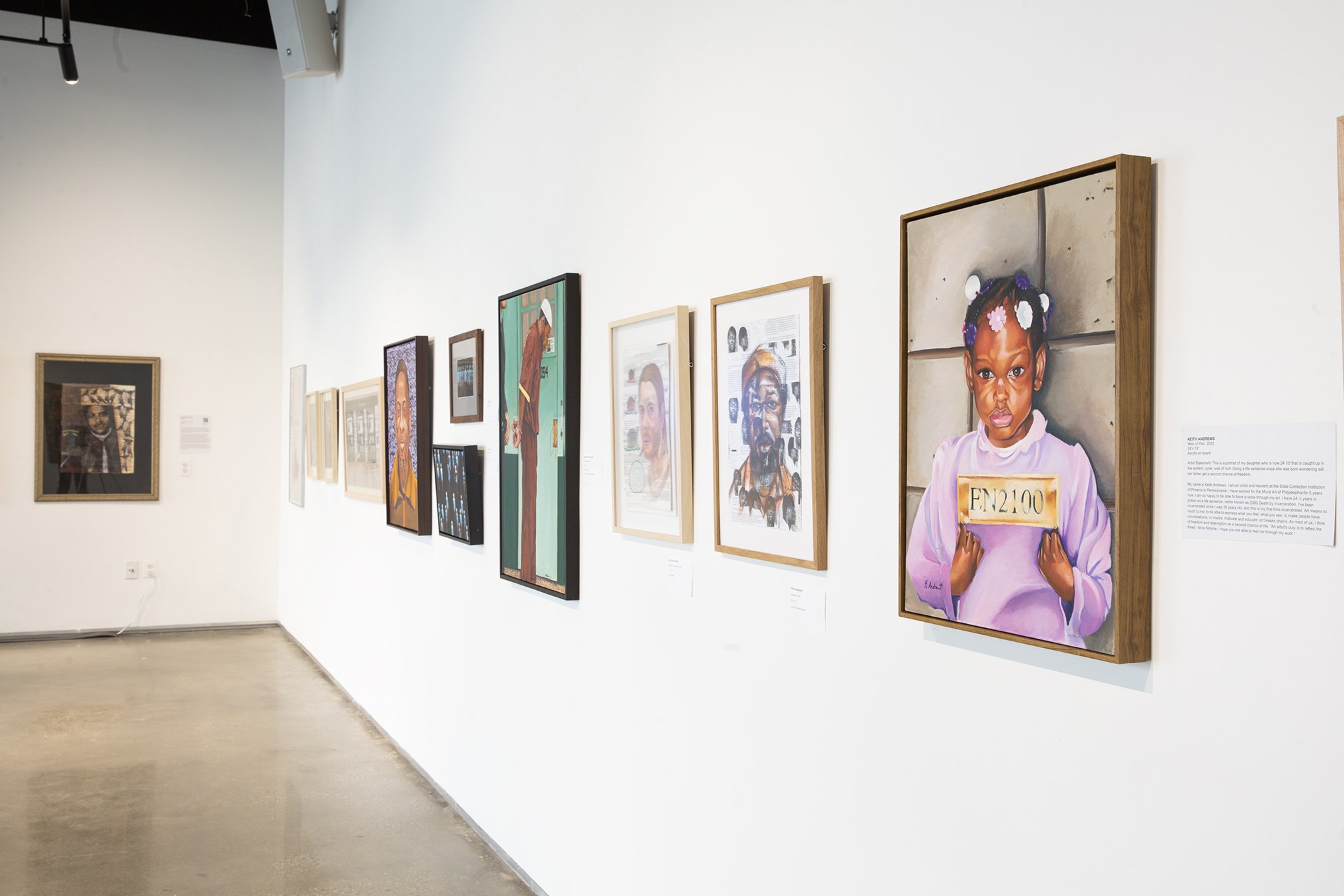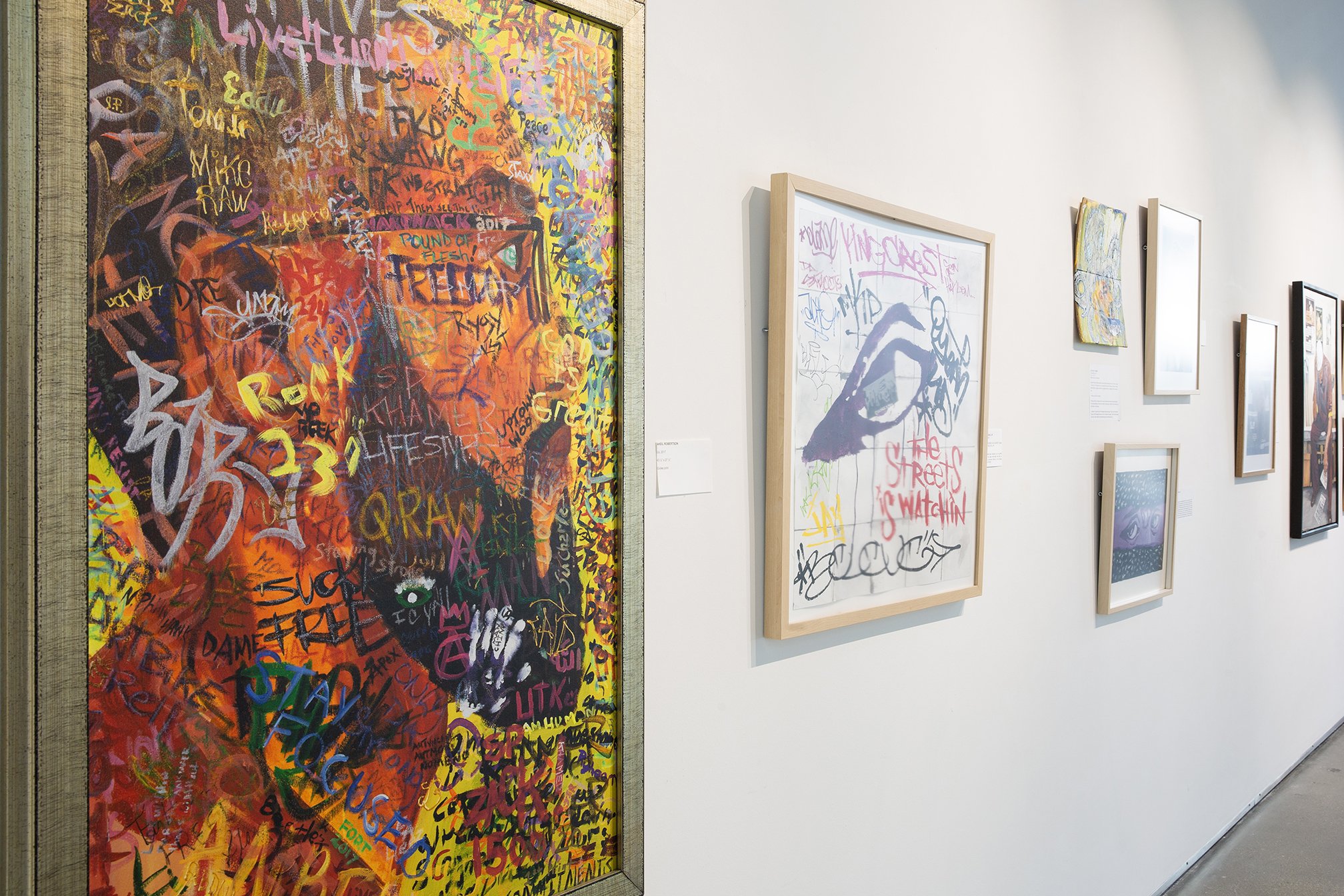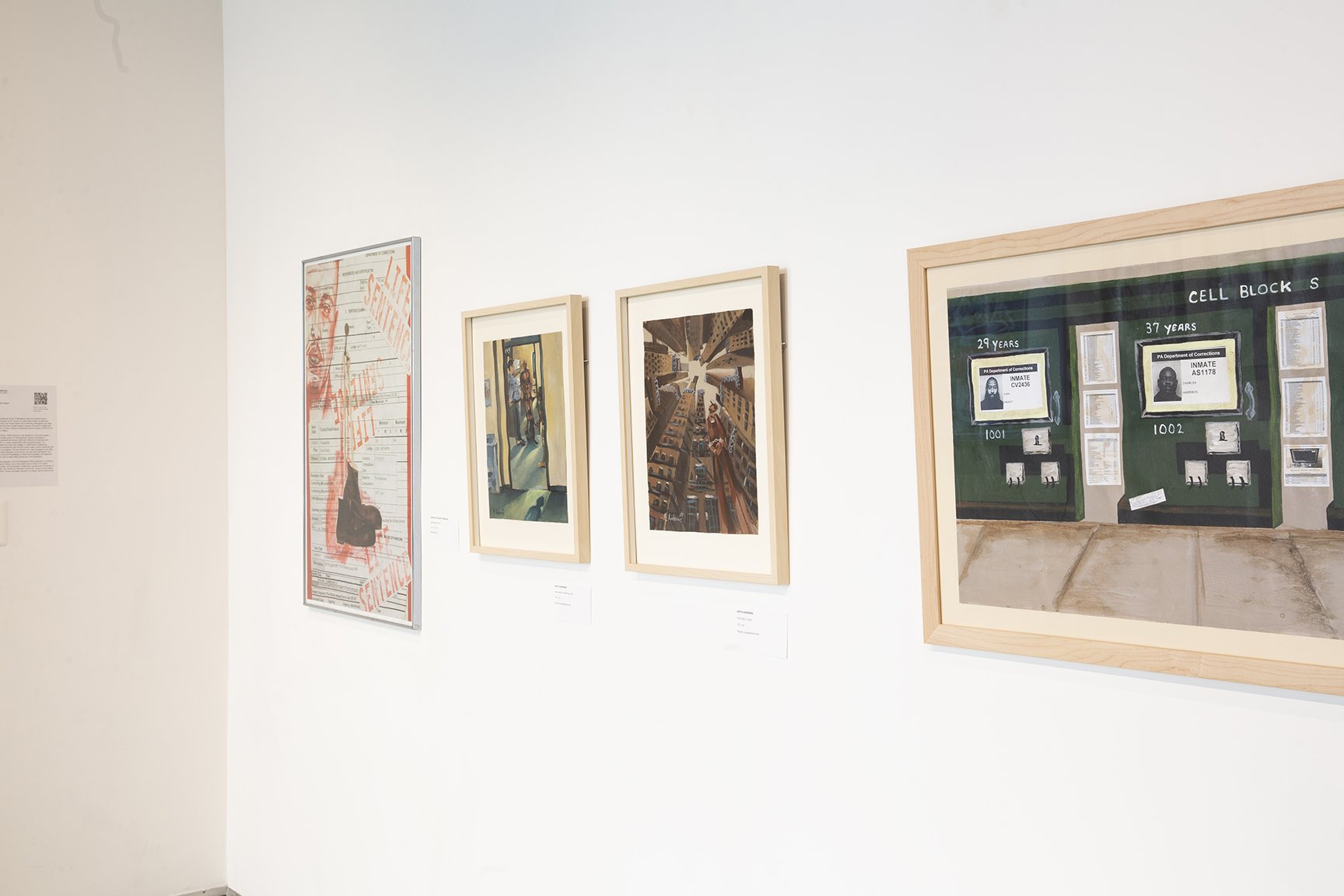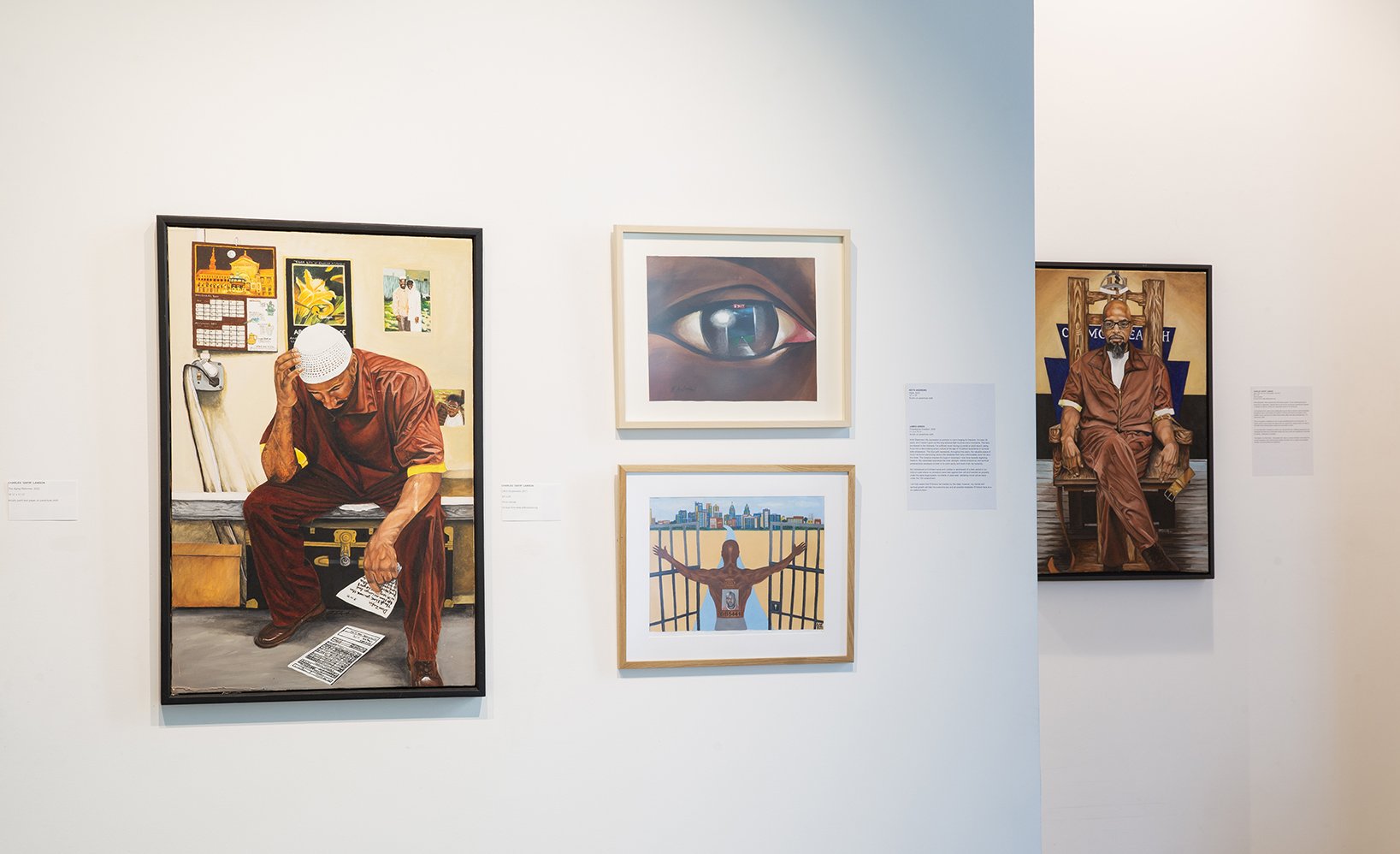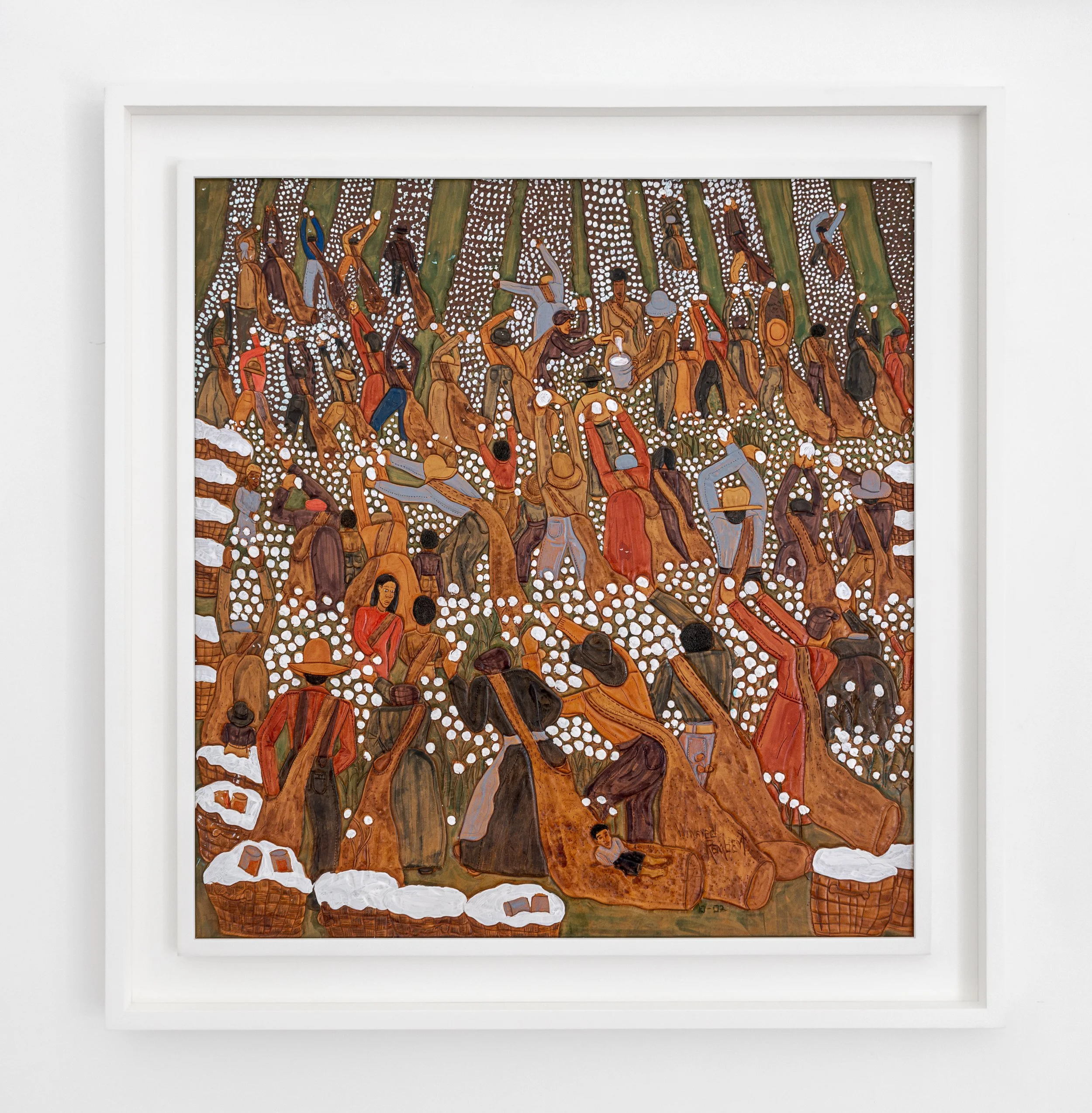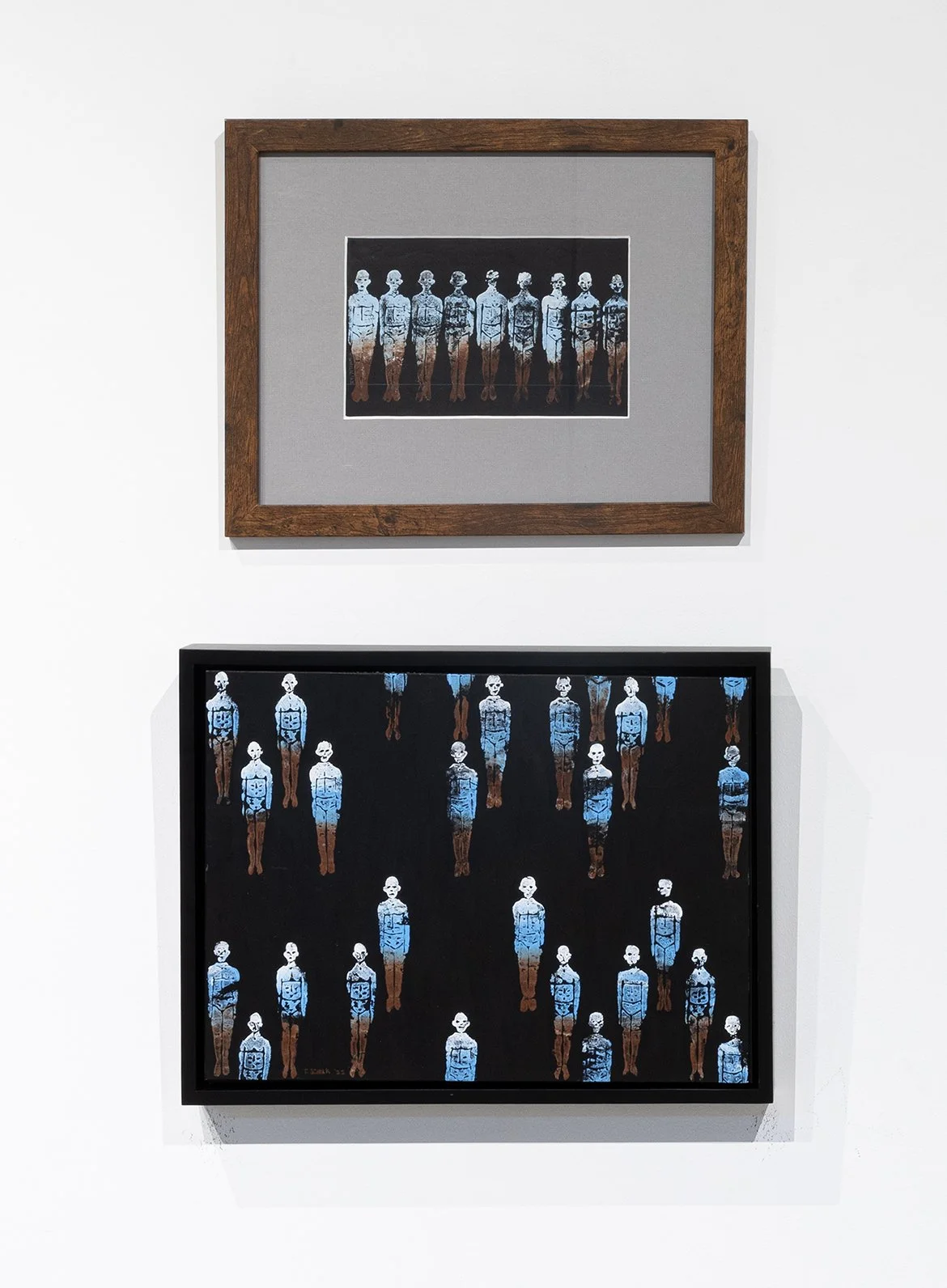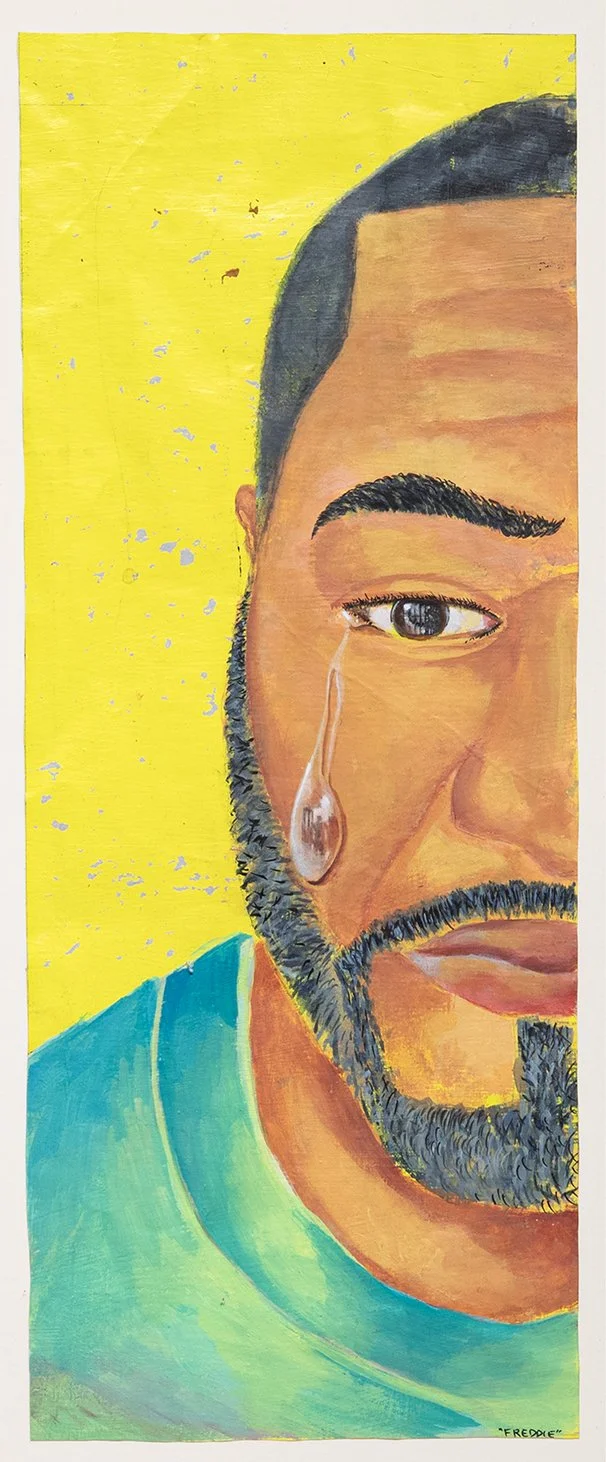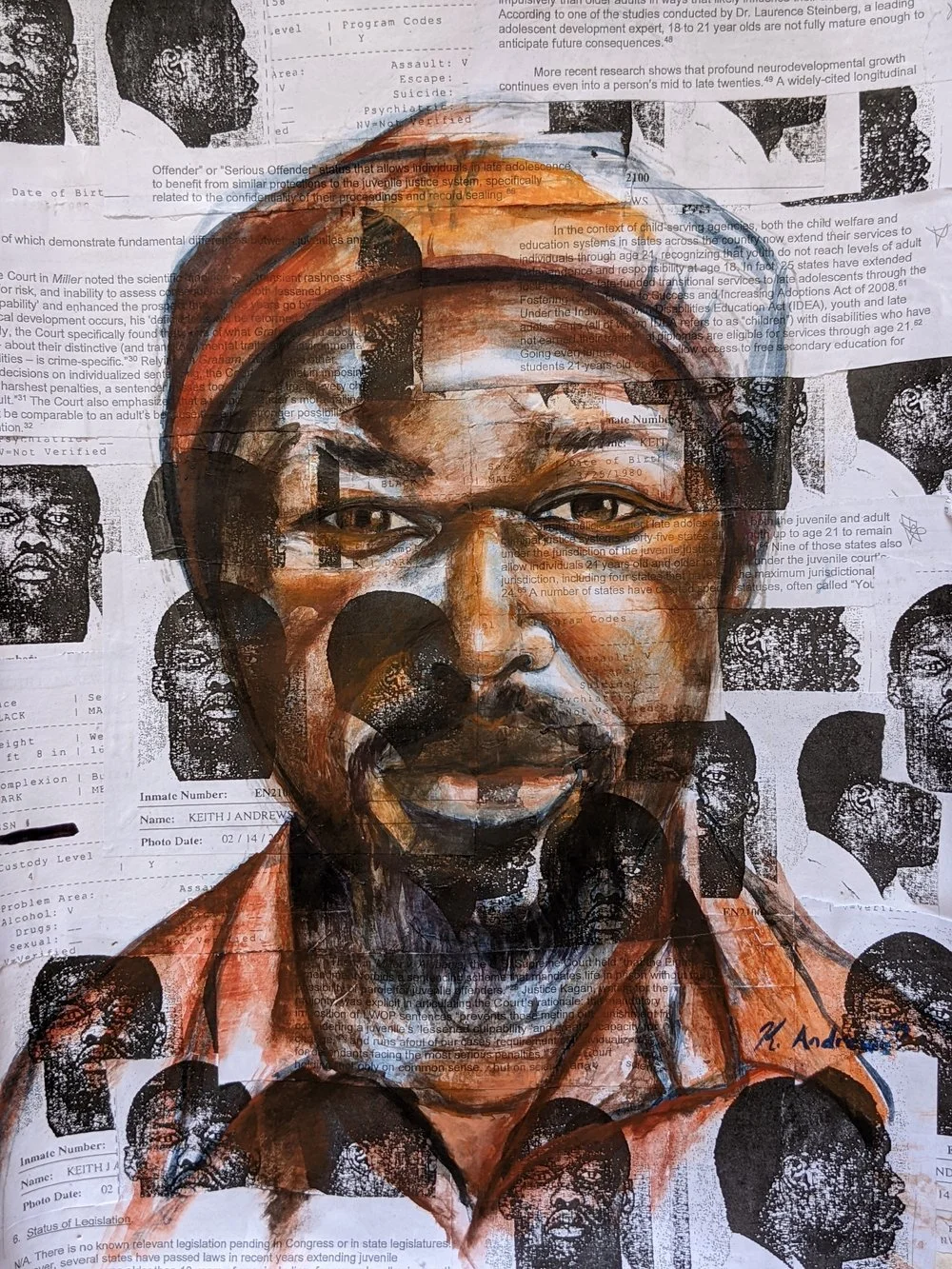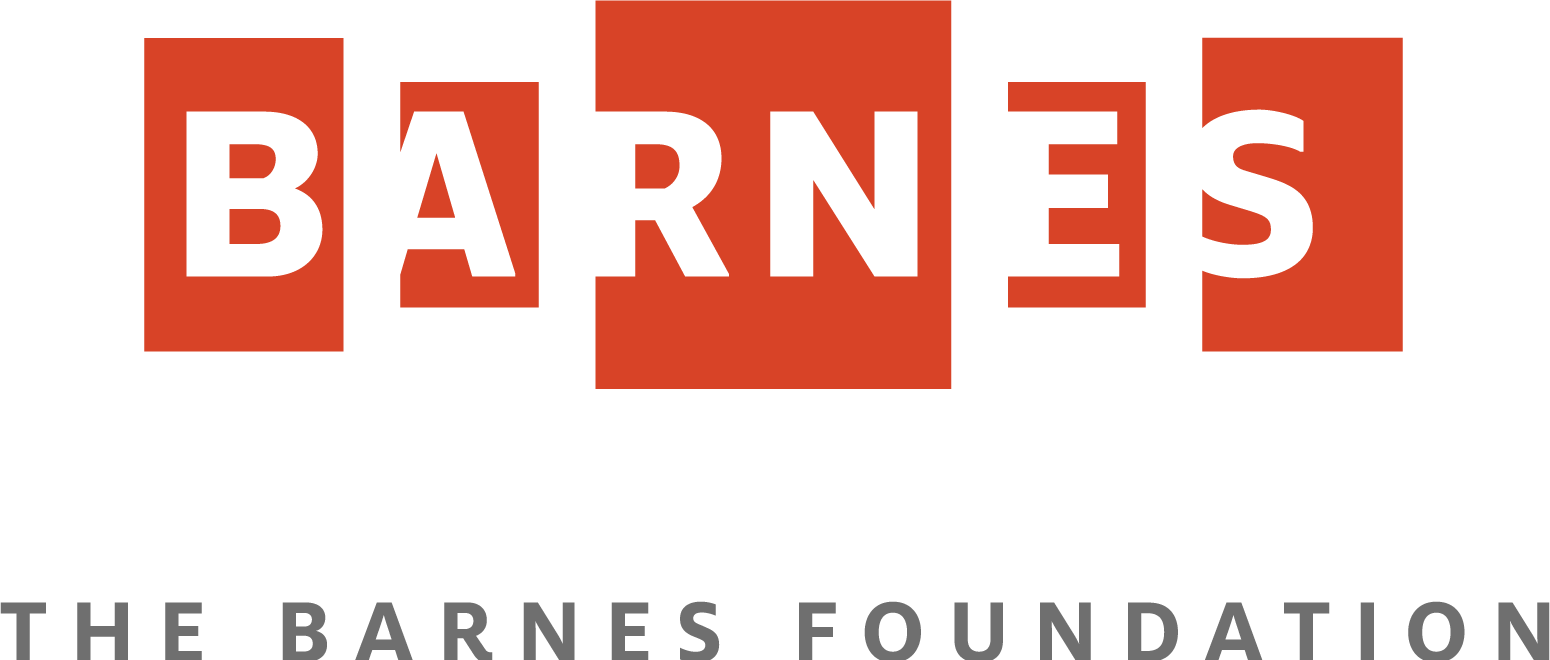FACES OF RESILIENCE
/Faces of Resilience
January 6 - March 30, 2024 @ Mason Exhibitions Arlington
Mason Square Campus
Curated by William Perthes, Bernard C. Watson Director of Adult Education at the Barnes Foundation with supplemental curation by Alissa Maru, Mason Exhibitions
“Art made in prisons is crucial to contemporary culture, though it has been largely excluded from established art institutions and public discourse.”--Marking Time exhibition, MoMA PS1, 2020
There are many paths to mass incarceration: gentrification, the prison pipeline from poor education, generational white supremacy, political reform of mandatory sentencing, a general lack of societal resources, and many more. Faces of Resilience shares the effects of isolation, solidarity, and urges advocacy for reform.
Faces of Resilience features works by 14 previously or currently incarcerated artists who participate in year-round art workshops at SCI Phoenix, Southeast Pennsylvania’s maximum-security prison for men located 33 miles outside of Philadelphia. During the pandemic, these artists endured weeks of near-total confinement in shared six-by-12-foot cells. Many of these works visualize experiences of personal trauma and loss, they also reflect the love and support artists receive from family and friends. In addition to the 14 artists, the exhibit is supplemented by the works of three professional artists as well: Maria Gaspar, Sara Bennett, and the late Winfred Rembert (1945–2021).
This exhibition aims to humanize each of the artists’ experiences leading up to and during their incarceration, and to consider alternative paths beyond the existing carceral system. Although many of the artworks employ portraiture, mixed media using intake documentation, these artists have provided narratives to humanize their story, experiences of a life lived that many don’t see as they are removed from society.
Sara Bennett is a former public defender who feels that she provides stronger advocacy for sentence-reduction through her photography practice of following incarcerated women who have been given a life sentence. A handful of the women have received clemency. Their individual narratives are shown on the exterior windows of the gallery in life after life in prison, and outdoor media screen. Maria Gaspar is an interdisciplinary artist negotiating the politics of location through installation, sculpture, sound, and performance. Gaspar’s work addresses issues of spatial justice in order to amplify, mobilize, or divert structures of power through individual and collective gestures. In collaboration with George Mason University’s data mapping and art history scholars, Gaspar will continue to realize her goals of abolishing carceral spaces by adding prints of current prisons, jails, and immigrant detention facilities in Virginia to the Disappearance Jails project, which will ultimately be obscured through perforations by exhibition visitors. Pulitzer Prize winner Winfred Rembert received recent acclaim while alive and posthumously at art fairs and blue chip art houses. Rembert was subjected to police harassment and beatings and, on one occasion, nearly lynched. Winfred’s tooled leather skills were learned while incarcerated, serving time for a crime he did not commit. His genre scenes chronicle his life on a chain gang, near life-ending moments, picking cotton, and joyous moments in rural black south communities.
Additional participating artists from SCI Phoenix include: Keith Andrews, Al Collantes, James Green, Roy Holloway, Charles “Zafir” Lawson, Eduardo Ramirez, Felix W. Freddie Rodriguez, Jr., Robert E. Rigler, Thomas Schilk, Cody Stuhltrager, Akeil Robertson, Ronald Connelly, Derrick “JT” Taylor, Luis “Suave” Gonzalez, and Sir Charles Harrison.
Faces of Resilience is made possible through an ongoing partnership between Mural Arts Philadelphia and the Barnes Foundation who share a steadfast commitment to restorative justice of which this exhibition is one example.
Unfortunately, many of the artists in the exhibition will not be able to engage with viewers of the exhibition. If you have questions, feedback, or responses to the artwork that you would like to share, please click below.
On Saturday, October 14, 2023, Mason Exhibitions and the Carter School for Peace and Conflict Resolution played host to a daylong Art & Incarceration Symposium on the Fairfax Campus.
Watch the interview featuring Ronald Connelly and Suave Gonzalez.
ARTICLE
George Mason University's 'Faces of Resilience' Unites Art, Education, and Social Change
January 17, 2024 / By Lakin Raybuck
EVENT RECORDINGS
Faces of Resilience Virtual Artist Talk
On Wednesday, January 17, 2024, Mason Exhibition Arlington hosted a Virtual Artist Talk. The discussion delved into the artists' experiences with incarceration and explored alternative paths beyond the existing carceral system. The event featured William Perthes, Bernard C. Watson Director of Adult Education at the Barnes Foundation, and Alissa Maru, Mason Exhibition Curator.
Watch Maria Gaspar’s Visual Voices Online Presentation
PARTICIPATING ARTISTS AND ARTWORKS
Winfred Rembert
Black Playground, 2003 Dye on carved and tooled leather 31 1/2 × 35 inches
Courtesy by James Barron Art
While in prison, Rembert learned how to read and write. He also learned to tool leather from “T.J. the Tooler” and began making leather wallets, purses, and belts. Rembert eventually settled in New Haven with his wife Patsy, who he married after his release from prison in 1974.
Rembert’s life and work were also documented in the 2011 documentary All Me: The Life and Times of Winfred Rembert, directed by Vivian Ducat, and in the 2021 documentary Ashes to Ashes, directed by Taylor Rees for The New Yorker.
Winfred Rembert was born in 1945 in rural Americus, Georgia and grew up in nearby Cuthbert. Born out of wedlock, at three months old Rembert’s mother gave him to his great aunt to raise him.
Rembert began working in cotton fields and peanut farms in early childhood. He received very little schooling and by age 14 had dropped out to work full-time in the fields. At age 19 in 1965, Rembert attended a peaceful Civil Rights demonstration. The demonstration turned violent, and, fearing for his life, Rembert stole a car to escape two white men with guns. He was arrested and sent to prison without trial. He later escaped and survived a near-lynching after he was caught, an experience that would haunt him and his work. Rembert was then sentenced to twenty-seven years in prison, of which he served five years on a chain gang, followed by two years of construction work for good behavior.
On Mama's Cotton Sack, 2002, Dye on carved and tooled leather
32 1/4 x 30 1/2 inches
Courtesy by James Barron Art
Thomas Schilk
Artist Statement:
A few years ago, I had planned on doing a series of portraits of men who had been buried in prison for obscene amounts of time. Brother Wazir and Ronnie are both warm and lovely human beings who had been in prison for over fifty years each. My goal was to have an exhibit or space where I could use my art to advocate for the release of these fine men. Well, covid and some personal setbacks put an end to that. Mercifully, in the interim, both of these men were among the less than one percent of lifers to receive commutation. They're both now out, surrounded by love and adjusting as best they can. Sadly, so many others are still in.
Wazir
Acrylic on canvas, 2020
Ronald Connelly
Acrylic on canvas, 2020
Private Collection
Line Up
by Thomas Schilk
Acrylic on paper
2022
23 or More by Thomas Schilk
Acrylic on board
2022
“When we were spirited away from Graterford [in July of 2018], all of our property was taken from us with the hope that it would be returned when we reached Phoenix. That didn't happen. Along with other items, including a beloved pair of shoes, most of my art supplies came up missing, including my good brushes. Still, my paint got through which I was glad for.
I may have talked before about how most of the guards handling us — separating us from our goods, stripping us down, transporting us, etc. — were white and the majority of those being handled were black. It was troubling and reminded me of Michelle Alexander’s book, "The New Jim Crow" — an informative and important work. I had also read Zora Neale Thurston's "Barracoon,” about an African man's capture and transport on the last slave ship to enter our nation. For me, it’s all related and these thoughts informed my work.
Without brushes, I made a series of drawings of similar men. Then I took some Styrofoam trays (we were locked in for quite a while after the move, and that's what they fed us on) and taped the drawings over them. After that, I pushed a sewing needle through the outlines of the drawings as a guide. Next, I cut out the shapes and added details by carving lines into the pieces. Finally, I spread colors on some cardboard, rubbed the cutouts in them and stamped the piece out over a phthalo blue background. After some touch-ups, the piece was done.
While the concept was born in the darkness of being mistreated in prison and informed by knowledge of the historical mistreatment of blacks and other marginalized people in our nation, I chose brighter colors here because I didn't want to send too much darkness to the person who received the piece. While unintentional, the finished piece has a kind of pop art feel, which I like. Anyway, I hope you like it. By the way, both books are worthwhile reads, especially Alexander's. “
Ronald Connelly
Artist Statement: “I was born September 11, 1944. Immediately afterwards, placed in a number of foster homes, and later, juvenile institutions. By order of the court, at 18 years old, I entered the Army in November 1962. Did my basic training at Fort Dix’s , New Jersey, then assigned to Wurtzburg, Germany. Discharged November 1965. Returning to Philadelphia, I worked at Business Men’s Clearing House, United Parcel, and Scalamandri Silks. Not making enough money working for others, I ran a speakeasy, prostitution and gambling ring, and sold cocaine. Would be arrested for running numbers, check cashing schemes, and narcotics. Arrested in July 1971 for impersonating an FBI agent and murder in Delaware County, PA. After 3 days of jury deliberation, in 1973 I was sentenced to life in prison. While in prison, I acquired my GED, Associates Degree, and taught myself the Arts. It’s through Art and Higher Education that I came to know of the origins of men, evolution, history, and art history. With such knowledge, I found wonder and appreciation. I also found in prison, loneliness and despair.”
Interior of the Prison Mausoleum by Ronald Connelly
Acrylic on canvas, 2017
Collection of Akeil Robertson
Open Boxes of Art by Ronald Connelly
Acrylic on canvas, 2017
Collection of Akeil Robertson
Self Portrait (After Shepard Fairey) by Al Collantes
Acrylic on parachute cloth, 2023
Artist Statement: “A face of resilience to me is my daughter, Ebony Collantes. She had the weight of a broken world in front of her. She had every excuse not to succeed in this world. However, she pushed forward and worked hard to make herself successful in this broken world that I created through my harmful mistakes and erratic actions. Ebony, I regret not being there for you, unable to lift you up when you needed it. I’m sorry for not being a father you deserve, and for the actions that have kept me away from you. I’m proud of the woman you have become and hope I can make amends for all the sadness I caused you.”
The Aging Reformer by Charles “Zafir” Lawson
Acrylic paint and collaged paper on parachute cloth, 2022
Artist Statement: “When sentenced to life without parole, I found myself searching for some form of happiness. I learned that my art can be moving and inspirational to people in despair as well as to those who appreciate beauty in the visual arts. I co-founded Art for Justice (www.artforjustice.org) so that my artwork could be exhibited throughout many communities and locations. Working with friends and artists on the outside, my art and the art of others behind these walls have been exhibited over 110 times since 1997. One of my goals in exhibiting my art is to give something back to my community – to inspire youth to look at their own talents and turn aways from violence which can lead to the halls of the criminal justice system and eventually to prison.
It is my hope that in viewing my artwork you may see life from a different perspective and recognize that there are incarcerated people who have worth and something to contribute to society - redemption is possible. This leads to my final hope – that people who value my artwork will learn more about the current injustices in the criminal justice system and then work to create more equitable, humane, and just policies and institutions.
Web of Pain by Keith Andrews
Acrylic on board, 2023
Artist Statement: “This is a portrait of my daughter who is now 24 1⁄2 that is caught up in the system, cycle, web of hurt. Doing a life sentence since she was born wondering will her father get a second chance at freedom.
My name is Keith Andrews. I am an artist and resident at the State Correction Institution of Phoenix in Pennsylvania. I have worked for the Mural Art of Philadelphia for 5 years now. I am so happy to be able to have a voice through my art. I have 24 ½ years in prison on a life sentence, better known as (DBI) Death by incarceration. I've been incarcerated since I was 18 years old and this is my first time incarcerated. Art means so much to me; to be able to express what you feel, what you see, to make people have conversations, to inspire, motivate and educate; art breaks chains. As most of us, I think of freedom and redemption as a second chance at life. “An artist's duty is to reflect the times” -Nina Simone. I hope you are able to feel me through my work “
Us by Akeil Robertson
Giclee print
2017
Mass Incarceration by James Green
Acrylic and paper on board
2023
Sir Charles Harrison “King” by Derrick “JT” Taylor
Air brush on board
Charles “Zafir” Lawson
Artist Statement: “When sentenced to life without parole, I found myself searching for some form of happiness. I learned that my art can be moving and inspirational to people in despair as well as to those who appreciate beauty in the visual arts.
I co-founded Art for Justice (www.artforjustice.org) so that my artwork could be exhibited throughout many communities and locations. Working with friends and artists on the outside, my art and the art of others behind these walls have been exhibited over 110 times since 1997.
One of my goals in exhibiting my art is to give something back to my community – to inspire youth to look at their own talents and turn aways from violence which can lead to the halls of the criminal justice system and eventually to prison.
It is my hope that in viewing my artwork you may see life from a different perspective and recognize that there are incarcerated people who have worth and something to contribute to society - redemption is possible.
This leads to my final hope – that people who value my artwork will learn more about the current injustices in the criminal justice system and then work to create more equitable, humane, and just policies and institutions.
Life in Suspension by Charles “Zafir” Lawson
Oil on canvas, 2011
Life in PA: Are You Comfortable, Yet by Charles “Zafir” Lawson
Hope by Keith Andrews
Acrylic on parachute cloth, 2023
One Heck of a Morning by Keith Andrews
Acrylic on parachute cloth, 2023
You Can Stand by Sir Charles Harrison
Acrylic on parachute cloth
2023
Life Sentence by David Luis “Suave” Gonzalez
Mixed Media
David Luis “Suave” Gonzalez
About the Artist: Through his colorfully confrontational works, Philadelphia artist and activist Suave Gonzalez proves the political power of art. Suave is a self-taught street muralist and artist, working mostly with acrylic and mixed-media. He inventively reimagines pop style portraiture and highly political work that visually speak to issues of human struggle and justice. After serving 31 years years in prison, Suave is extremely proud of being a 2018 Art For Justice Reimagining Reentry Fellow.
Suave grew up in the South Bronx. While serving a Life Sentence in the sixth largest prison in America, Graterford State prison in Pennsylvania, Suave committed to becoming the voice for the voiceless-he earned a BA from Villanova University and worked as president of LACEO, a Latino organization that has giving away 110 scholarship funded by inmates from their own wages. In 2008 Suave created the Education Over Incarceration scholarship with his own prison wage. Suave continued this community-based work after his release. He had worked as a case manager for the 25th Police District, assisting low level offenders avoid prison. He was also the Director of a resource center in the heart of North Philadelphia; In 2020 Suave painted 100 essential workers who are risking their lives to help others during the Covid pandemic.
Suave was a 2014 TEDx talk presenter, a 2018 Philadelphia TEDx presenter, a 2018 Art For Justice Reimagining Reentry Fellow. He is the creator and co-host of 'A Justice Conversation', author of 6 novels, and had taught a watercolor course at the University of Pennsylvania off campus site 'The Center for Carceral Community'. Suave is the subject of the acclaim podcast 'SUAVE'. Suave Gonzalez was born to inspire, and his drive to do so is boundless.
Big House Noodle Soup by David Luis “Suave” Gonzalez
Mixed Media
Open Letter to the Public by David Luis “Suave” Gonzalez
Mixed Media
Philadelphia Freedom by James Green
Acrylic on parachute cloth, 2022
Artist Statement: “My expression is symbolic to one’s longing for freedom. It’s been 34 yrs and I haven’t given up the long arduous fight to prove one’s innocence. The bars are likened to the darkness I’ve suffered never having a juvenile or adult record, being thrust into a demoralizing prison culture at the age of 19 without experience or survival skills whatsoever. The blue path represents, throughout the years, the valuable peace of mind I’ve found overcoming various life obstacles that many unfortunately cave into as a first timer. The distance inspires the hope of closeness I now have towards regaining freedom. My nakedness expresses the inner strength, mental endurance and spiritual perseverance necessary to hold on to one's sanity and most of all, his humanity.
My institutional commitment name and number is reminiscent of a dark period in our history's past where my ancestors were held against their will and branded as property under the same legal system, hundreds of years later, declaring me an actual slave under the 13th amendment.
I am fully aware that I'll forever be branded by this state, however, my mental and spiritual growth will help me overcome any and all possible obstacles I'll forever face as a so-called ex-felon.”
The Streets is Watching by Felix W. “Freddie” Rodriguez, jr.
Collaborators: King Crest, BLAME, Al Lito, BLAZE, Oyeah Kid, WACK O, Jeok, MKD, BELEVE, JAY
Acrylic on parachute cloth, 2023
Artist Statement: “This piece was inspired by my graffiti days in New York City, but, also reminded me that no matter how many video cameras there is, the streets always see it and know it FIRST!”
A Cry for Freedom by Felix W. “Freddie” Rodriguez, jr.
Acrylic on parachute cloth, 2023
Artist Statement: “This is how I've been feeling for the last 27 years in this cage. Crying and hoping that one day I will get to see myself walking out of this cage.”
I Am Human by Thomas Schilk
Acrylic on board, 2017
Artist Statement: “This is supposed to look like an advertisement - think Absolut vodka - it's my attempt to rebrand myself.
A lot of the harm done, in and out of prison, results from our tendency to “other” each other. A big part of that process is by labeling - freak, faggot, whore, terrorist, criminal, whatever. What results is a denial of people's humanity. In prison our humanity is under constant assault by these processes. This work is meant to not just tell others I'm human but to remind myself of that too.”
Camouflaged by Robert E. Rigler
Cloth, parachute cloth, paper, marker, acrylic paint, 2022
Artist Statement: “Art helps keep me going. I had several thoughts about why I painted my face different colors, why I attached a real COVID mask and painted camouflage colors. I remember thinking when I volunteered to be a paratrooper when in the army. I was in the All American Division 82nd Airborne. I thought when I get out I should be able to get a good job with an honorable discharge, good conduct medal, presidential citation, silver wings. All good but I became an alcoholic who just drank when off duty. I brought that home with me. Now at home I collect unemployment checks for months, then try to get a job, no luck. One businessman said to me, “Did you just get out of the army?” He advised me not to wear my army field jacket to job interviews saying, “People are afraid of vets.” Well no welcome home, now as a vet I could not get a job for almost a year. I did not let that stop me. I got several jobs, lived with an old girlfriend, but started drinking again, which helped put me in prison. The DA used my military service to help convict me. Now going on 49 years in prison. I feel vets of the Vietnam era were unseen, camouflaged. I survived false evidence, a forever sentence, over 48 years in prison, COVID. I'm still a vet. Never giving up. Your best bet. Free a vet.”
Reflection by Keith Andrews
Acrylic on parachute cloth, 2022
What Do You Think I Am? by Cody Stuhltrager
Mixed media, 2022
SARA BENNETT OUTDOOR INSTALLATIONS
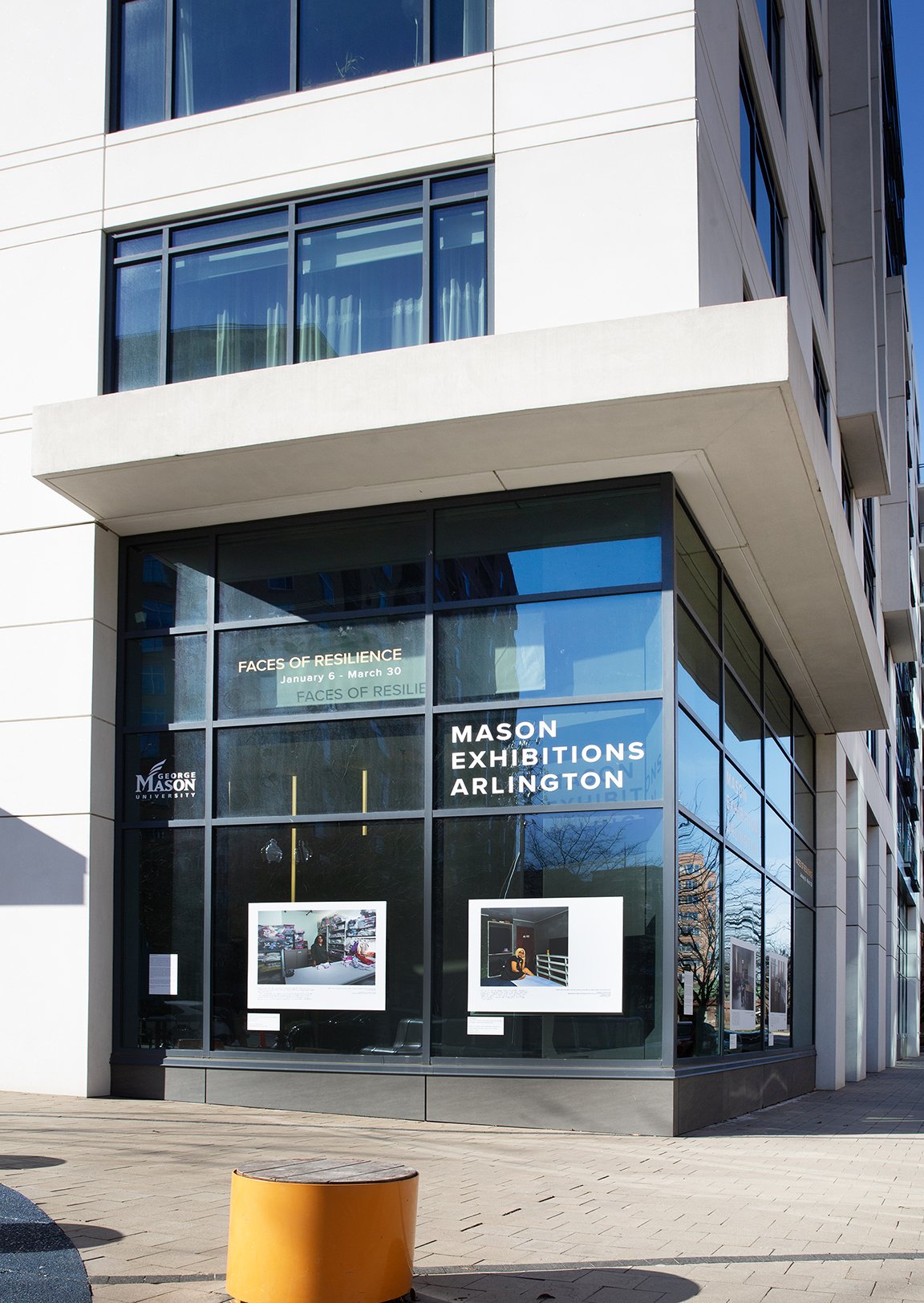
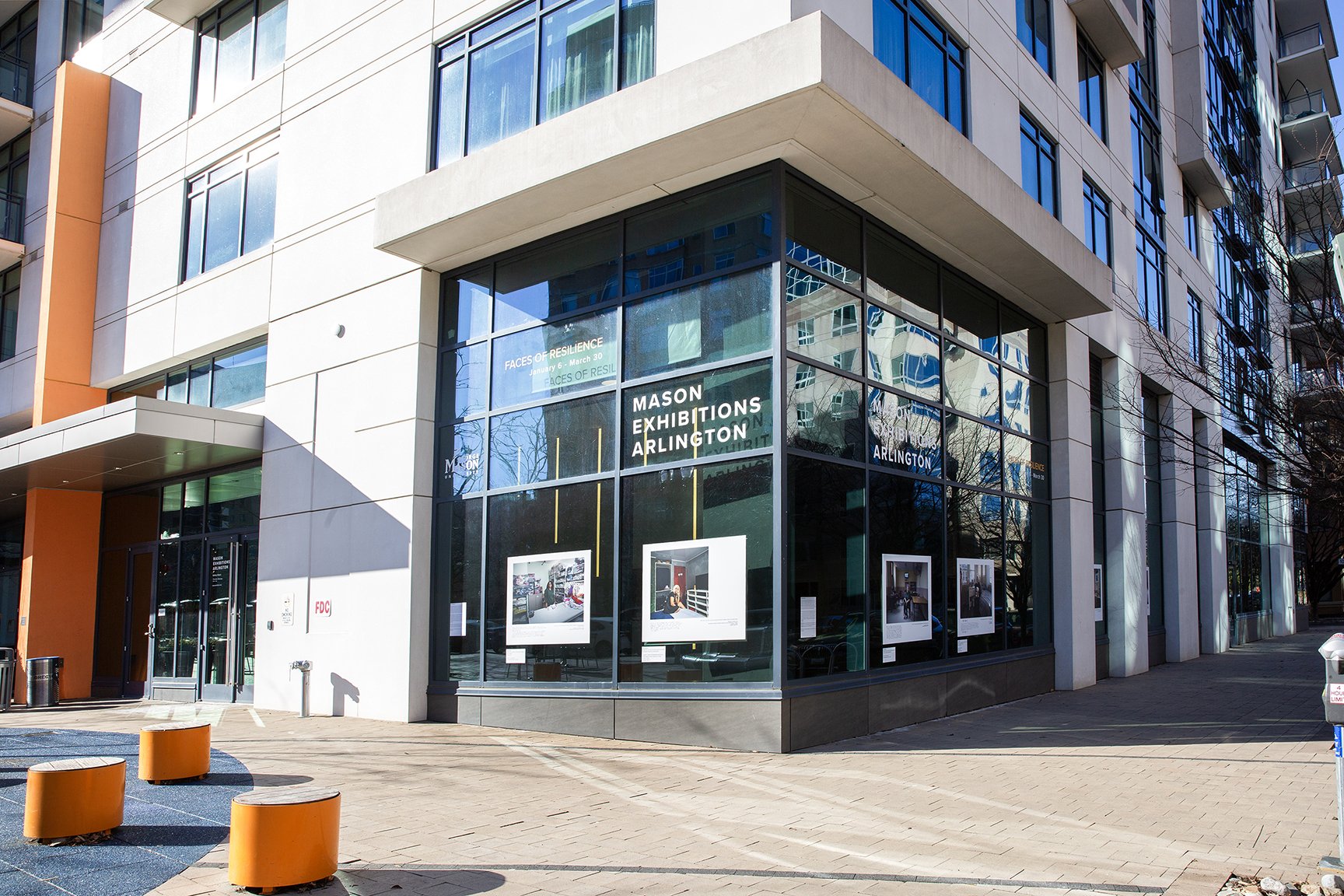
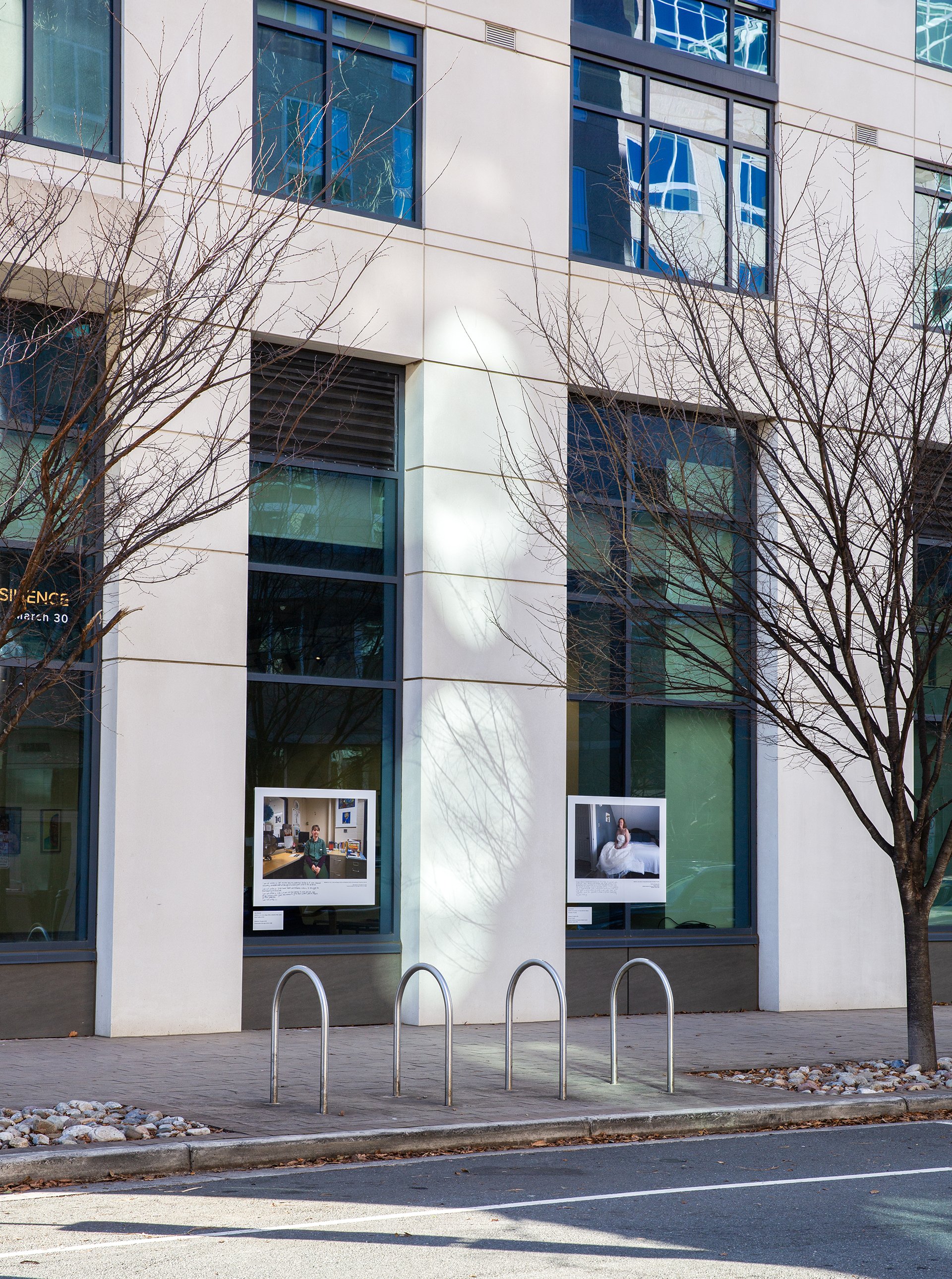
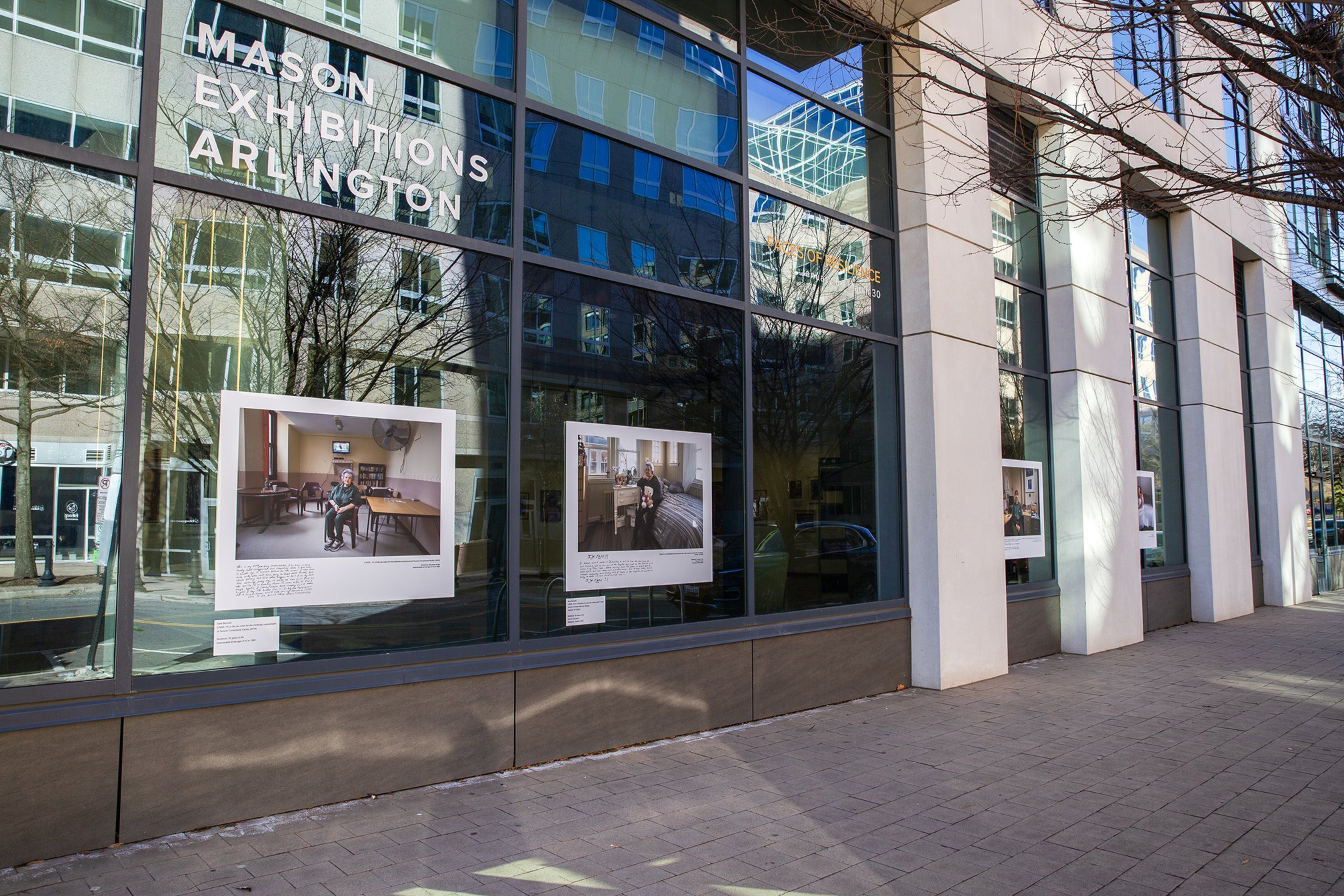
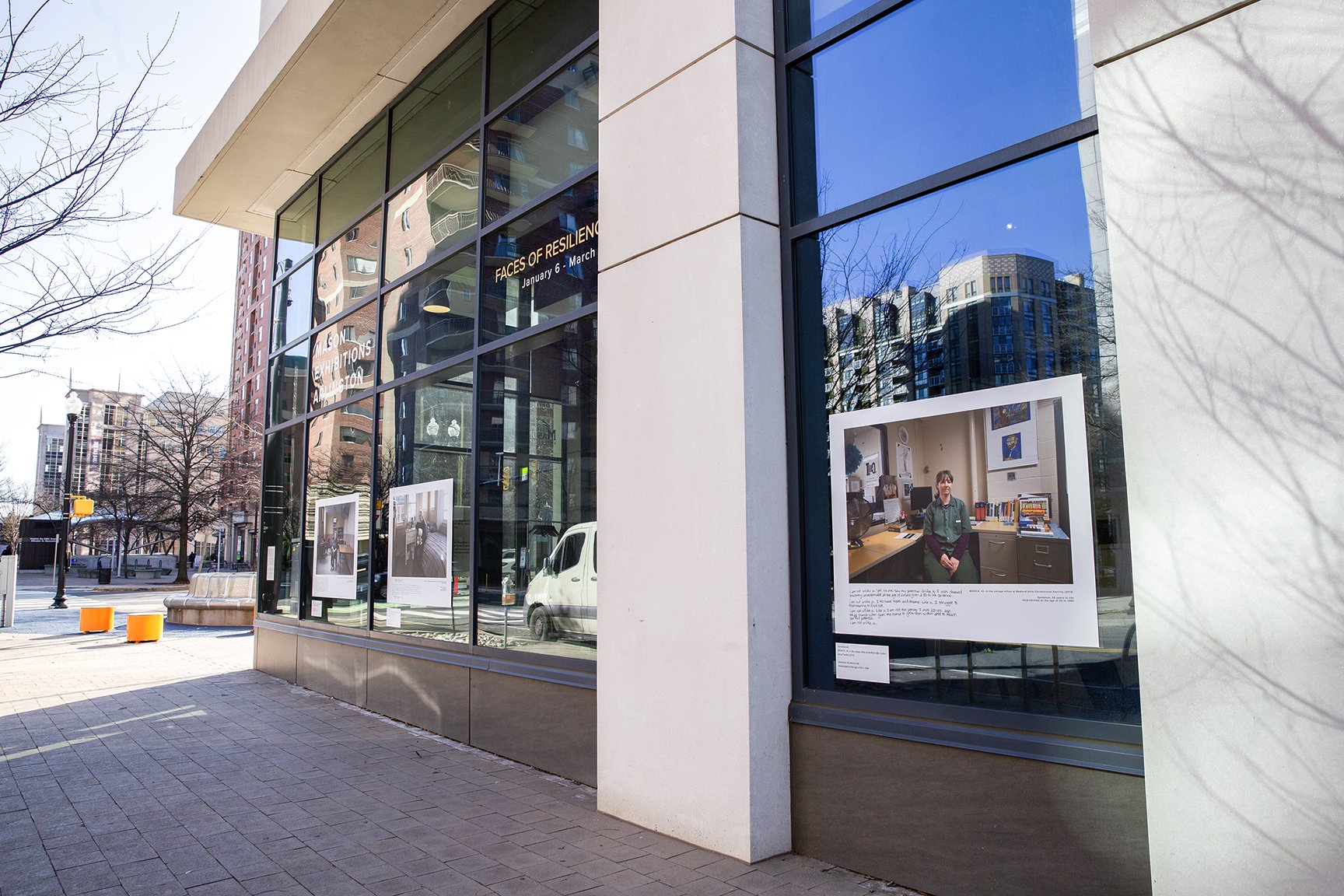
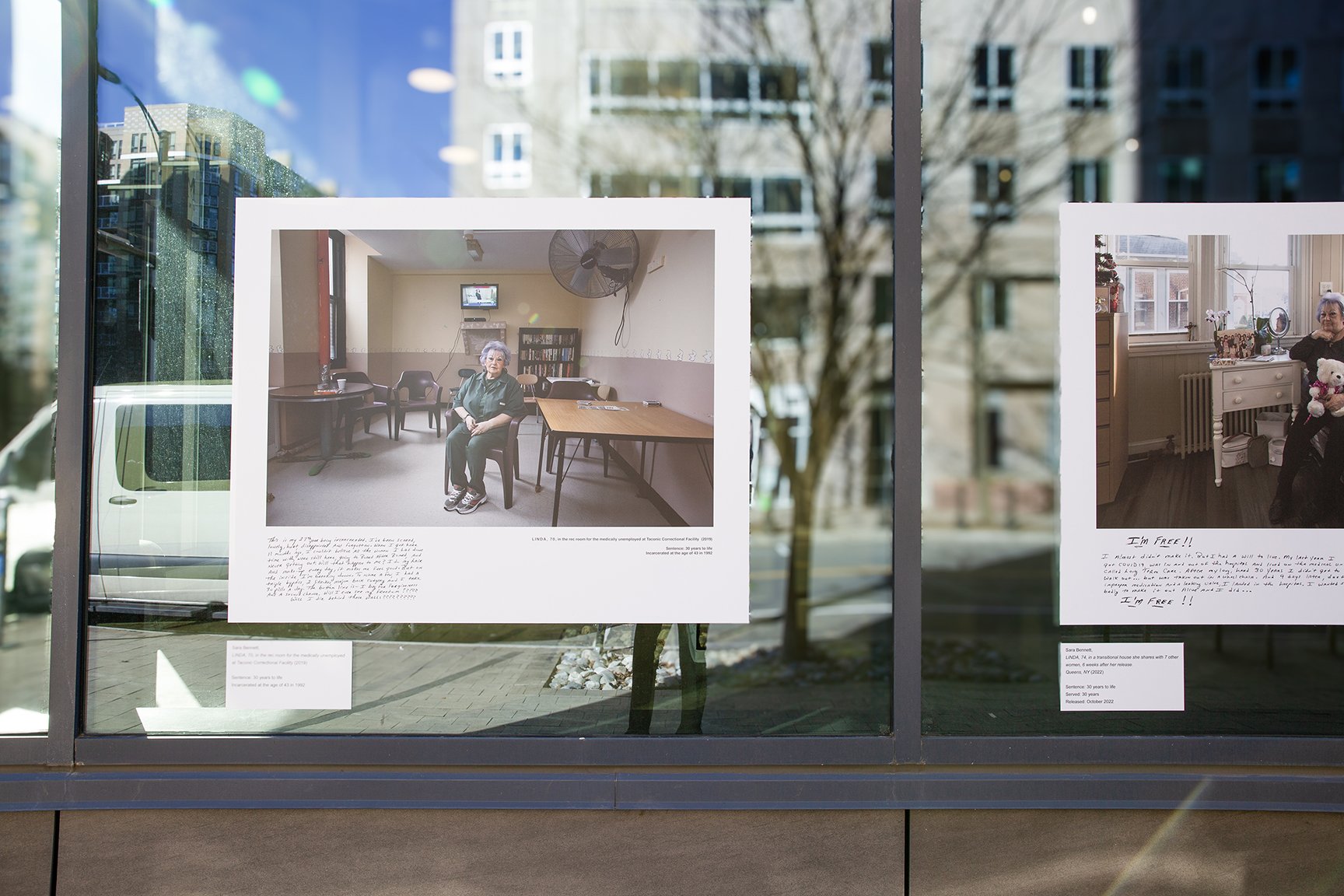
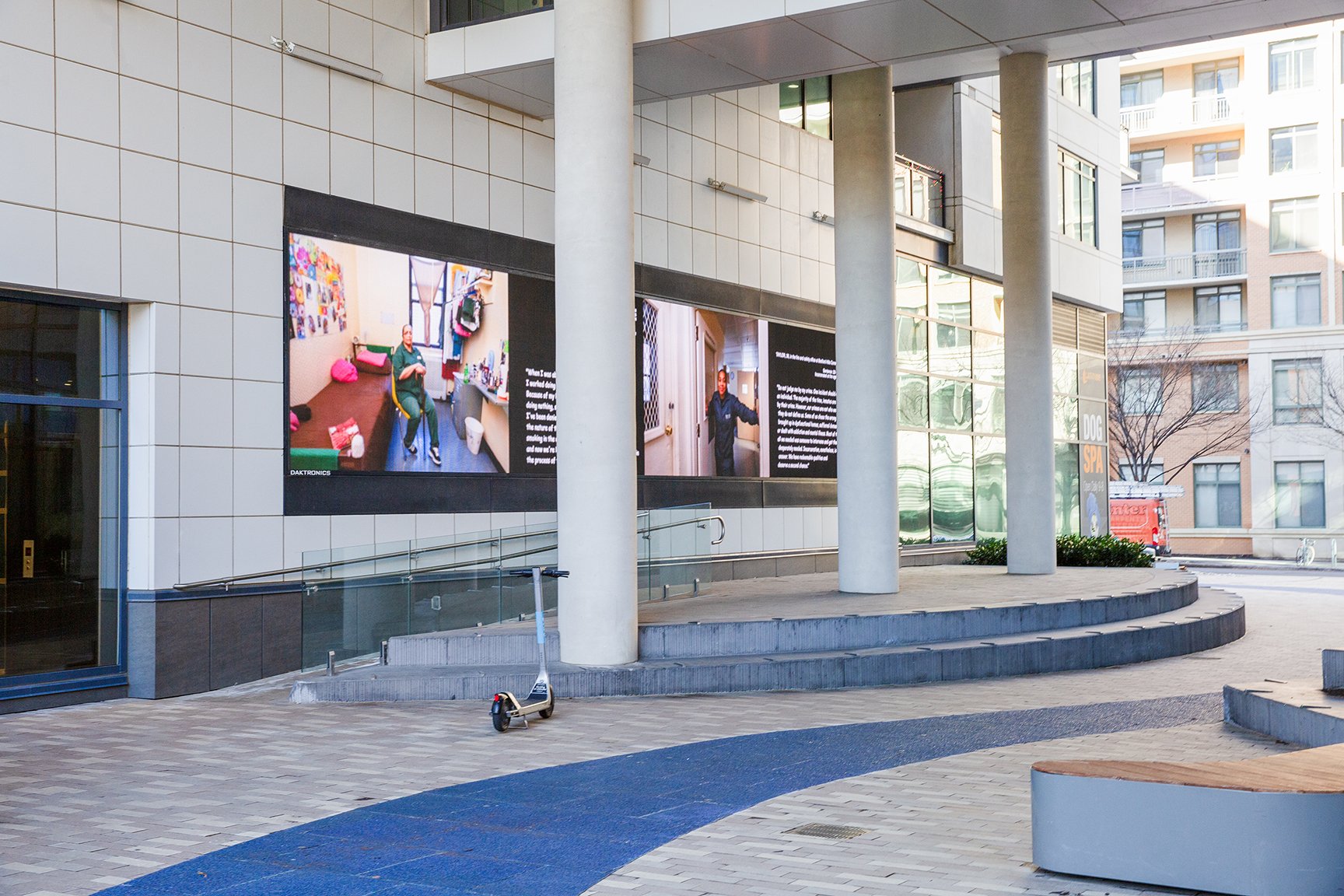
After 18 years as a public defender, Sara Bennett turned her attention to photographing women with life sentences, both inside and outside prison. Like the women she photographs, Bennett hopes her work will shed light on the pointlessness of extremely long sentences and arbitrary parole denials.
More than 200,000 people in the United States are serving life sentences, a punishment that barely exists in other western countries. I've long believed that if judges, prosecutors, and legislators could see people who have been convicted of serious crimes as individuals, they would rethink the policies that lock them away for decades or even sometimes forever.
For the past ten years, I have been photographing women who were convicted of serious crimes - mostly homicide - and were given life sentences. Some of them have been freed after serving anywhere from 14 to 37-1/2 years in prison, and I photographed them in their most private spaces - their bedrooms. Others are still incarcerated and I photographed them in their prison environments.
Each woman, is so much more than the one act that sent her to prison. They are all hard-work-ing, resilient, introspective, and remorseful. They strive to live meaningful lives.
Which leaves us with the question: what do we do with a redeemed life?
Artist Website : https://sarabennett.org/
OUTDOOR DIGITAL SCREEN
MARIA GASPAR
Disappearance Jail
Disappearance Jail is an ongoing art research project by Maria Gaspar that aims to record the eventual erasure of carceral geographies in each of the 50 states within the US. Prints depicting current prisons, jails, and immigrant detention facilities across the US are obscured through perforations using a hole puncher. Images are sourced online, while others can only be sourced through specialized databases or satellite imagery. The penetrations enact the abolition of carceral sites. Through the gesture of perforation, the sites are rendered fragile – susceptible to disintegration by the slightest touch. Participatory community events or “Punch Parties” have occurred within each state and by local community members.
Mason Exhibitions and an Art History graduate student, Esther Perez, have partnered with Maria Gaspar and her team to document active prisons, jails, and immigrant detention facilities, and ultimately perforate images of the facilities during community "punch parties" in an effort to abolish and reimagine carceral spaces. So far, the states of Illinois, Ohio, and California have been documented, and we added Virginia in Spring 2024!
Radioactive: Stories from Beyond the Wall
Radioactive: Stories from Beyond the Wall is a series of community-engaged radio/visual broadcasts located between the largest architecture of Chicago’s West Side, the Cook County Jail, and the working-class residential area of the Lawndale communities. Radioactive centers the voices of those currently incarcerated by broadcasting and projecting intimate and creative stories from inside Cook County Jail to outside its' border.
On September 15-16, 2018, the project debuted in a large-scale public art event at the north-end wall of Cook County Jail. Community members, passersby, and members of the ensemble gathered to watch the North-side wall bordering the Cook County jail become a screen transformed by audio and animations created by currently and previously detained individuals.
The Visibility Project
The Visibility Project was presented in 2014 by the Visible Voices Ensemble and Bobby Biedrzycki at the Goodman Theatre, in collaboration with the 96 Acres Project. The Visibility Project is an intergenerational community performance and art-based action taking place outside Cook County Jail including poetry, theater, and kite flying led by the Visible Voices Ensemble in collaboration with the Goodman Theatre's Department of Education and Community Engagement.
CLAIM's Visible Voices of CGLA Visible Voices is CLAIM's support and empowerment group. The group, run by and for formerly incarcerated women, is dedicated to building our skills, creating humane policy change and to advocating for incarcerated women. Visible Voices meets at the Grace House transitional home near the United Center on west Adams Street, at CLAIM, or at other locations for special events.
Goodman Ed is the branch of the Goodman Theatre that provides opportunities to explore not only the world of our productions, but also the related ideas and themes that resonate within our lives. Operating through a lens of social justice and civic engagement.
Stories from the Inside/Outside
Video documentation of a 96 Acres Project event through a two-part projected animation loop. Two animations were projected onto the Cook County Jail Wall by artists examining the effects of incarceration. These humanizing and personal stories depict both sides of the wall—from the perspective of a family and those behind bars. “Letters Home” describes a story between a daughter and her incarcerated father, told through his letters over a ten year period and narrated by the daughter, Melissa Garcia. Artists Hector Duarte, Susan Mullen, Melissa Garcia, and Claudia Rangel collaborated to produce an animation that describes the tension and difficulties within a family experiencing a sense of loss. In collaboration with the Prison + Neighborhood Arts Project, we also projected “Freedom/Time” by artists Damon Locks, Rob Shaw, and eleven incarcerated men at Stateville Correctional Center. They explored the idea of time and notions of freedom through original hand-drawn animations. With intermissions of youth-generated text by by Yollocalli Arts Reach.
INSTALLATION VIEWS
